‘IT’S ALL DANCE’
Boundary-breaking choreographer Dwight Rhoden adds new angles to a storied art form.

UNIVERSITY MAGAZINE SUMMER 2023
DANIELE C. STRUPPA, PH.D.
President
MATT PARLOW Executive Vice President and Chief Advancement Officer
JAMIE S. CEMAN
Vice President of Strategic Marketing and Communications
JEFF BROUWER
Assistant Vice President of Brand Identity and Visual Strategy
RACHEL MORRISON, PH.D. Assistant Vice President of Communications and Brand Strategy
EDITOR
Dennis Arp
PHOTOGRAPHY
Adam Hemingway
ART DIRECTOR
Julie Kennedy
CONTRIBUTING DESIGNERS
Alex Quintanilla (MFA ‘22), Jillian Warren ‘24
CONTRIBUTING WRITERS
Stace Dumoski, Joy Juedes, Lauren Sieberg (MA/MFA ‘25), Cerise Valenzuela Metzger, Story Winfield
PROJECT MANAGER
Karan Sirna
EDITORIAL OFFICE
One University Drive, Orange, CA 92866-9911
Delivery issues/unsubscribe from print magazine/change of address: email magazine@chapman.edu.
Chapman Magazine is published biannually by Chapman University. ©2023 Chapman University.
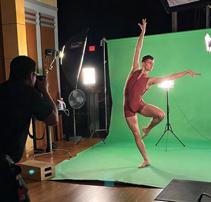
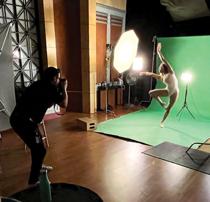
Reproduction in whole or in part without written permission is prohibited.
Periodicals postage paid at Orange, Calif., and at additional mailing offices.
Chapman Magazine is printed on paper certified by the Forest Stewardship CouncilTM, which sets standards for responsible forest management.
The mission of Chapman University is to provide personalized education of distinction that leads to inquiring, ethical and productive lives as global citizens. Chapman.edu
Emerson Donohoe ‘24, Kevin Ivins ‘24
Professor Dwight Rhoden
FEATURES 10 Through a Lens of Humanity 14 Game-Changing Potential for Global Food Security 18 ‘It’s All Dance’ 26 A New Era for Dance 30 Digging Dinos 34 Chapman Engineering Lab Adds Cutting-Edge Laser System 36 Trailblazers 40 Enter the Dream Machine 42 The Long View on Leadership 46 Having a Ball – With Physics? 48 Supportive Community Aids With Recovery 50 The Global Dean + 3 UP FRONT 52 IN MEMORIAM 54 CHAPMAN NO W 60 ALUMNI NEW S CHAPMAN U NIVERSITY MAGAZINE SUMMER 2023 IN THIS ISSUE ON THE COVER: Chapman dancers
and Makaila Teagle ‘25 – all students of
demonstrate new angles on an antique art form. The layered triptych of dancers on the cover evokes the manifold disruptions,
to the
–
from the physical
intellectual, occurring in the creative industries.
C000000 FPO
NOTES ON A DREAM: CARNEGIE HALL
BY MADISON WEISS ’24
I think most musicians dream of getting to perform at Carnegie Hall. I have been dreaming about it since I was a child. On March 19 at 1 p.m., that dream came true.
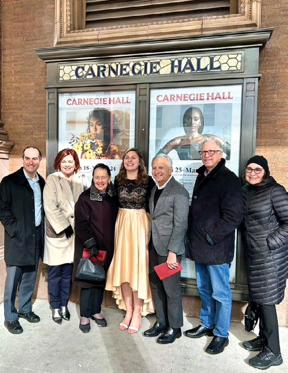

It was thrilling to walk out on that stage, to look around and take in the hall, to bow before the crowd and take my seat at the piano, knowing that I was about to perform on the Carnegie stage. I performed Liszt’s Ballade No. 2 in B minor. It was such a fulfilling feeling to play that grand, impressive piece and hear it echo throughout the hall. It’s always a joy to share a composer’s message and feelings with an audience so that together we can experience the music and emotions. It was especially thrilling to share such a special moment with so many members of the Chapman Family who had traveled to New York to support me.
When I finished playing my last note, I listened as the sound lingered in the hall. My heart was full of joy. I thought, “Wow, I just performed a piece I love in the hall that I have been dreaming of performing in for years.”
I am so grateful to have had this opportunity, just as I am blessed to have family and friends who support me. It means so much to grow as a performer and as a person in this caring community.
In the audience to support Weiss (center) were (from left) Executive Vice President Matt Parlow, Sandy Henson, Trustee Marybelle Musco, President Emeritus Jim Doti, Trustee Mark Hilbert and Professor Emerita Lynne Doti.
As a two-time winner of the grand prize in the Elite International Music Festival, pianist Madison Weiss ’24 was invited to perform at Carnegie Hall. It was a dream moment for the Chapman University junior, a solo piano performance student in the College of Performing Arts.
SUMMER 2023 | 1
MESSAGE FROM THE PRESIDENT INSPIRED TO PURSUE GREATNESS
It takes an uncommon level of confidence for an institution to set its sights not just on improvement but on greatness. I’m pleased to say that Chapman is just such a place.
Our next-level aspirations are right there in the title of our new five-year strategic plan, “Our Path to Greatness,” which we unveiled in February during my annual State of the University address. I’m excited to pursue this blueprint for accelerating the rise of our university, already in rapid ascent.
Ours is a commitment to an inclusive vision of academic excellence, built on the quality and dedication of our students, faculty, staff and alumni along with the support of our Trustees and Governors. You can learn more about this new plan at chapman.edu/strategicplan
As we map a comprehensive strategy for our future, we also celebrate that our people are already doing great things all across our 11 schools and colleges, our two campuses and our growing global footprint. In this issue of Chapman Magazine, you’ll meet some of those ground-breakers turning curiosity into discovery and inspiration into impact as they improve lives throughout the communities we serve.
Dwight Rhoden exemplifies that spirit of innovation, as you’ll read in our cover story, beginning on Page 18. For three decades, the choreographer and co-founder of Complexions Contemporary Ballet has been stretching the boundaries of dance, bridging styles as he amplifies diverse perspectives. Now, as a faculty member in our exceptional Department of Dance, he is helping students reach new creative heights.
The opportunities for those artistic breakthroughs are expanding greatly thanks to the opening of our new Sandi Simon Center for Dance (see story on Page 26). The generosity of Ron and Sandi Simon has been transforming lives at Chapman for years, thanks to their support of the Simon Scholars and other university programs. Now this amazing new dance facility has reimagined a historic space to create new opportunities for current students and countless ones to come.

On Page 14, you’ll also learn about the cutting-edge work of ecosystem scientist Joshua Fisher, whose research model predicted every global food security crisis within record three months in advance. “This is going to save lives,” Josh says of his discovery. It’s hard to imagine a greater impact than that.

Throughout this issue, the work of difference-makers is on display.
Oscar winners and nominees take student filmmakers inside their process during Dodge College master classes (Page 8).
Nobel Peace Prize Laureate and Presidential Fellow in Peace Studies Nadia Murad offers insights on ethical research and advocacy (Page 10).
Students from multiple disciplines get an immersive experience with legendary paleontologist and Honors professor Jack Horner (Page 30).
Other students extend Chapman’s 15-year commitment to a city and a service-learning project as they peel back the layers of leadership in the aftermath of Hurricane Katrina (Page 42).
These stories and more provide a window to this extraordinary time in the history of our university. We continue to climb in the national rankings (Page 56), build on our R-2 Carnegie Classification for high research activity, and commit to gaining full recognition as a Hispanic Serving Institution and as an Asian American and Native American Pacific Islander Serving Institution. As we do, we are attracting support to fuel all of our exciting opportunities to elevate the Chapman Experience.
In February, we launched the public phase of Inspire: The Campaign for Chapman University with a goal of raising $500 million by 2028. As of May 1, more than $325 million had been raised to ensure that Chapman is uniquely positioned to transform lives and inspire real change for generations to come.

As members of the Chapman Family, you are foundational to our university’s rise and critical to our future success. Today more than ever, I’m convinced that the ambitious goal of greatness is within our collective reach.
With gratitude,
Daniele C. Struppa President, Chapman University
2 | CHAPMAN UNIVERSITY MAGAZINE
BEN JANDA ’23 WINS CHEVERTON AWARD
BY STACE DUMOSKI
BECKMAN AND GOLDWATER SCHOLAR EARNS CHAPMAN’S HIGHEST UNDERGRADUATE HONOR.
Senior chemistry major in Schmid College of Science and Technology Ben Janda has been named the recipient of the Cecil F. Cheverton Award for 2023.
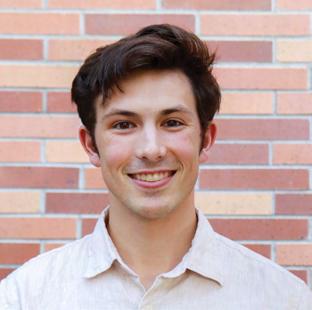
“I genuinely don’t think that any of my academic achievements or potential could have been tapped into if it weren’t for the professors I’ve had and the mentors that I’ve worked with,” said Janda, who was a recipient of the Barry Goldwater Scholarship and a Beckman Scholar last year.

“[The award] shows how far I’ve come, but that was because of the hard work of a lot of other people as well,” he said.
Janda, who plans to attend UCLA in the fall to pursue a Ph.D. in chemistry, said that his time spent doing undergraduate research — his lab work has focused on investigating organic catalysts they hope will be more sustainable and cost-effective replacements for precious metals — has been a key highlight of his time at Chapman.
“[The award] shows how far I’ve come, but that was because of the hard work of a lot of other people as well.”
“I work with Dr. Allegra Liberman-Martin, an organic chemistry professor. And my time in their lab has been nothing but positive,” he said, adding that the experience more than compensated for a sophomore year spent entirely remote thanks to the COVID-19 pandemic.
“I had such an amazing experience in the lab that I’ve been working in and as a result of that, I’ve been able to travel and give talks, and I’ve won some scholarships and awards that have helped me out with school,” he said.
“Ben has thrived in a research environment, where his attention to detail has led him to discover that an unexpected chemical reaction was occurring in his experiments,” said Liberman-Martin, Ph.D. “He readily contextualizes his results in the broader field of catalysis and designs creative experiments to test new hypotheses. Ben is also excellent at communicating his research to both chemists and a wider audience.”
Janda also works as a student tour guide on campus. “I have fantastic bosses and amazing coworkers, and I think that relaying my experience to prospective undergraduate students has been just remarkable because I am glad that I have a positive experience to portray to them.”
Janda’s advice for younger students is to jump at every opportunity that presents itself.
“One thing that’s kind of surprised me about myself is that, in high school, I wasn’t really like that,” he said. “But just my willingness to do new things has really expanded. And that’s something that I want to carry with me for the rest of my life.”
The Cheverton Award is the oldest and highest undergraduate student honor, awarded by a vote of the full Chapman faculty. A gift of the class of 1929, the original bronze Cheverton Award cup remains on exhibit in Argyros Forum along with its successor, a silver bowl. These trophies are engraved with the names of all Cheverton awardees since 1929.
- Ben Janda ’23
“If someone ever says to you that you are ‘doing too much,’ you tell them, ‘I’m just getting started.’ If someone ever questions whether you’ve earned your seat at the table of prosperity, you tell them, ‘Not only have I earned my seat, but I’m prepared to allow you to sit beside me once you’ve respectfully earned yours.’”
SUMMER 2023 | 3 UP FRONT
- Angela Bassett, during her Chapman Commencement address
CLASS OF 2023: DRIVEN TO SUCCEED
A PASSION FOR NEUROPSYCHOLOGY
BY JOY JUEDES
From laboratory breakthroughs to creative triumphs to scholarly achievements, the Class of 2023 knows what it means to work hard, give more and contribute to the overall success of a community. As Chapman University graduates head off into the world to find their futures, here are just a few we are celebrating for all they have accomplished already.
Amy Whitmarsh is already making her mark in neuroscience, including on several projects at Chapman University’s Institute for Interdisciplinary Brain and Behavioral Sciences (Brain Institute).
She was awarded a 2022 Summer Undergraduate Research Fellowship (SURF) and an Undergraduate Scholarly Creative Grant, and she presented her work at two national neuroscience gatherings.
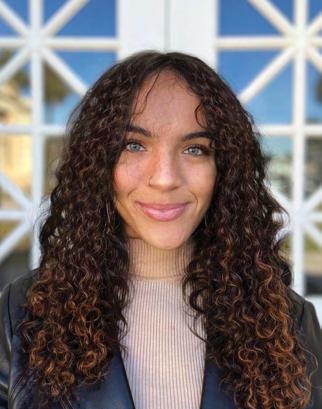
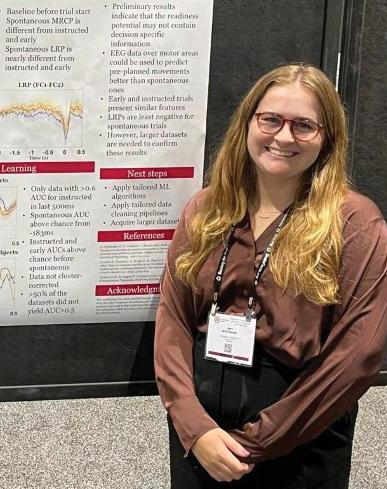
“At Chapman, you can get into a research lab and work directly with graduate students and professors,” Whitmarsh says.
Associate Professor Caroline Wilson, director of the neuroscience minor in Crean College of Health and Behavioral Sciences, says Whitmarsh “has demonstrated her
‘THE TRUE RENAISSANCE SCHOLAR’
BY DENNIS ARP
When Berkana McDowell decided to double major at Chapman, combining environmental science and policy with peace studies, “it seemed like the most intuitive thing I’d ever done,” she said.
“I framed my peace studies experience to focus on social justice, which is directly applicable to the environmental movement and applying ways to change systems.”
McDowell took it a step further – developing a minor in studio art that tapped her passion for painting and her skills as a muralist.
“Everything felt very connected,” she said.
Everywhere McDowell went she built community at Chapman, whether performing with the Floor 13 hip-hop dance team, collaborating on a communication toolkit in response to a coastal oil spill,
ability to aptly contribute intellectually to the scientific investigation.”
Whitmarsh has worked with Assistant Professor Aaron Schurger on several Brain Institute research projects, including how consciousness plays into free-will decisions. She presented a poster on the project at the Society for Neuroscience’s annual meeting in San Diego and has worked on projects studying facial perception in autistic children.
As she works at the Brain Institute as a postbaccalaureate research assistant, Whitmarsh plans to pursue a Ph.D. in neuroscience or psychology. She wants to work in neuropsychology, looking at how disorders like autism influence behaviors.
counseling student colleagues as a peer advisor or interviewing prospective students as an Admission fellow.
“Berkana is an example of the true renaissance scholar that Chapman strives to produce,” said Assistant Professor Richelle Tanner, co-director of the Environmental Science and Policy Program. “Her research in my lab explored how strategic use of environmental psychology improves environmental literacy in minoritized populations. Berkana has been a fierce advocate for environmental justice in the ES&P core curriculum.”
This fall, McDowell will continue her academic journey at Yale University, where she’ll pursue a master’s degree in environmental management.
4 | CHAPMAN UNIVERSITY MAGAZINE UP FRONT
LEADERSHIP THAT SPANS THE CAMPUS
BY STORY WINFIELD
Jack of all trades Kyle Tanimura is leaving quite the lasting mark on Chapman, where he has taken on multiple leadership roles as a double major in political science and strategic and corporate communication, with a minor in dance.
Tanimura is president of Chapman’s Filipino student club Kapamilya, founding president of the School of Communication Trailblazer Program for first-generation students (a story on the program begins on Page 38), and vice president of the Kappa Alpha Pi Pre-Law Fraternity. He’s also an orientation coordinator and a peer mentor for the School of Communication.
While he makes it look easy, he admits that tackling so many important roles isn’t for the faint of heart.
A NIMBLE DANCE BETWEEN DISCIPLINES
BY STACE DUMOSKI
Lauren Bramlett always knew she would double major. While dance was a passion, she sought balance in her education and future career.
“I have found that my English major makes me think about dance a lot more critically, which has helped me as a choreographer and a dancer,” she says. “And my dance major helps me with English – to see connections and see language as something more tactile and less abstract.”
A Summer Undergraduate Research Fellowship (SURF) allowed her to fully explore the intersection. She did a rhetorical analysis of 50 years of famous dance pieces (1950-2000) as a response to societal movements. The project included a performance piece with choreography drawn from her research.
“I believe everyone has different thresholds for how much they can handle,” he says. “Knowing yourself and being able to set boundaries helps with managing multiple responsibilities. I often check in with myself to make sure I’m really passionate about everything I’m doing.”
As a 4+1 student, Tanimura will continue at Chapman for an additional year to attain his MS in health and strategic communication. Then the possibilities are expansive. He hopes to make waves in the entertainment industry as a dancer before eventually working in higher education and politics.
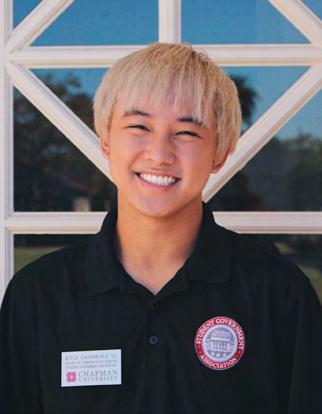
Her academic record includes an impressive slate of awards, but Bramlett has most enjoyed connecting with the campus community, including working as an orientation leader, serving in the Student Government Association, writing for The Panther student newspaper and serving on the editorial board of Calliope Art and Literary Magazine as well as a number of student advisory boards. This year, she was co-president of the Chapman Dance Alliance.
Bramlett will pursue a dance career after graduation, starting with a seven-month fellowship with Jacob’s Pillow, a dance center, school and performance space in Becket, Mass.
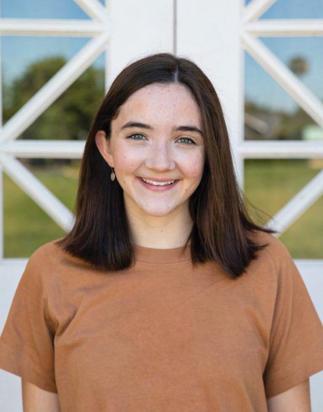
SUMMER 2023 | 5 UP FRONT
CURTAIN DOWN ON CHAPMAN CELEBRATES, CURTAIN UP ON $500 MILLION CAMPAIGN
BY JOY JUEDES
As the curtain came down on the annual Chapman Celebrates event for the final time, Chapman University announced a campaign to raise half a billion dollars for its students and campus.
The same weekend as the last Chapman Celebrates performances in February, Chapman President Daniele C. Struppa gave his annual State of the University address and unveiled Inspire: The Campaign for Chapman University, which aims to raise $500 million by 2028.
The campaign’s goals are to transform lives and communities, accelerate innovation and inspire excellence by supporting the ambitious goals of the university’s new strategic plan, “Our Path to Greatness.”
“This comprehensive campaign – ignited by the generosity of longtime supporters Jim and Kay Burra – will support the incredible ambitions of Chapman’s new strategic plan by supporting academic excellence,” said Jim Mazzo, who co-chairs the campaign with Lisa Argyros.
At the Chapman Celebrates gala at Musco Center for the Arts, Struppa made a surprise announcement of the Burras’ transformative $5 million gift as part of the campaign.
The Burras’ gift will create the Burra School of Accounting and Finance within Argyros School of Business and Economics, preparing the next generation of business leaders to take the helm in the rapidly changing fields of business and finance.
If that wasn’t reason enough to celebrate, Struppa also spoke to the impressive longevity and phenomenal fundraising success of Chapman Celebrates.
“First, we are celebrating the finale of an event that has brought together our Chapman Family in support of this institution for over 40 years, bringing in over $40 million for Chapman students,” he said.
Chapman’s signature fundraiser – originally called “An American Celebration” – has long featured Broadwaycaliber singing, dancing and musical performances from College of Performing Arts students. This year’s performances met their $1.5 million fundraising goal.


More than 80% of Chapman students receive some form of financial support, which flows from sources like Chapman Celebrates. In particular, the Chapman Celebrates talent scholarship supports performing arts students. The event was sponsored by Hank Adler, the Schmid family and Donna Ford Attallah ’61.
At Chapman Celebrates, attendees got a first look at the new Sandi Simon Center for Dance, which officially opened in March. Directed by Matt McCray, dancers were able to rehearse for the production in the new spaces.
Students perform in the last Chapman Celebrates production in February.
Singers and dancers in the College of Performing Arts bring four decades of vitality to the closing performance of Chapman Celebrates.
6 | CHAPMAN UNIVERSITY MAGAZINE UP FRONT
Struppa also recognized the co-chairs of the 2022 Chapman Celebrates, Melinda Masson and Casey Kasprzyk ’01.

“They put a great deal of time and effort into planning before the heartbreaking news of it being canceled [because of the pandemic],” he said.
Because this year’s event was the first inperson show since 2019, student performers showcased their triple-threat talents in their first and last Chapman Celebrates.
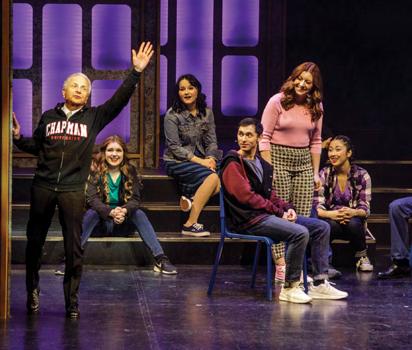
Performers dazzled with Broadway-quality versions of “You Can’t Stop the Beat” from “Hairspray,” as well as “Dancing in the Street” and “Holding Out for a Hero.” The production included Chapman scenes and backdrops and a dance cameo by President Emeritus Jim Doti.
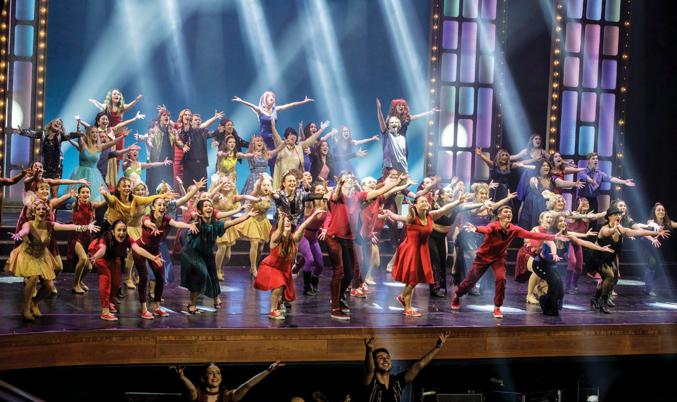
“As you’ve seen throughout the show, we’ve had many friends help us along the way,” Struppa said. “Those in the videos we just saw, so many of you who are here tonight, those who couldn’t make it … and many who are no longer with us but never forgotten. You have all provided inspiration and life-changing support to countless Chapman students.”
DEAN GIULIO ONGARO BIDS CHAPMAN FAREWELL
BY STACE DUMOSKI
“It has been bittersweet to say goodbye to Chapman Celebrates,” says Giulio Ongaro, who has been dean of the College of Performing Arts since 2015. “I enjoyed very much the creative part of putting together the show, picking the repertory and the concept with my collaborator, Matt McCray, a wonderful stage director. And, of course, watching the students audition, rehearse and perform was a highlight for me.”
Ongaro announced his retirement from Chapman this spring.
“I knew before I came to Chapman that this was going to be a great place to be as dean, and I am very grateful to President [Daniele] Struppa, who hired me when he was still chancellor. Everything he said back then about what Chapman had to offer was absolutely true,” Ongaro says. “This is a resourceful,
creative, entrepreneurial place, and I am proud to have played a small part in its current success.”
Ongaro plans to resume scholarly activities during his retirement, including organizing a sizable collection of documents about music in Venice in the 16th and 17th centuries. He is also planning to volunteer helping underserved local families by providing college counseling.
“I want to be able to explain clearly to them their choices and opportunities, to demystify the whole application and financial aid process, and help their children receive an excellent college education,” he says.
But first, he says, “I will take a deep breath and enjoy it. I have many interests, and I plan on spending a lot of time pursuing them with my wife, Cheryl.”
“You have all provided inspiration and life-changing support to countless Chapman students.”
- Daniele C. Struppa
President Emeritus Jim Doti makes an appearance in Chapman Celebrates.
SUMMER 2023 | 7 UP FRONT
Dean Giulio Ongaro and his wife, Cheryl.
THE MASTERS
PHOTOS BY GUSTAVO VERA ‘26
The goal is to connect Chapman film students “to the living, breathing industry,” says Steven Galloway, dean of the Dodge College of Film and Media Arts.
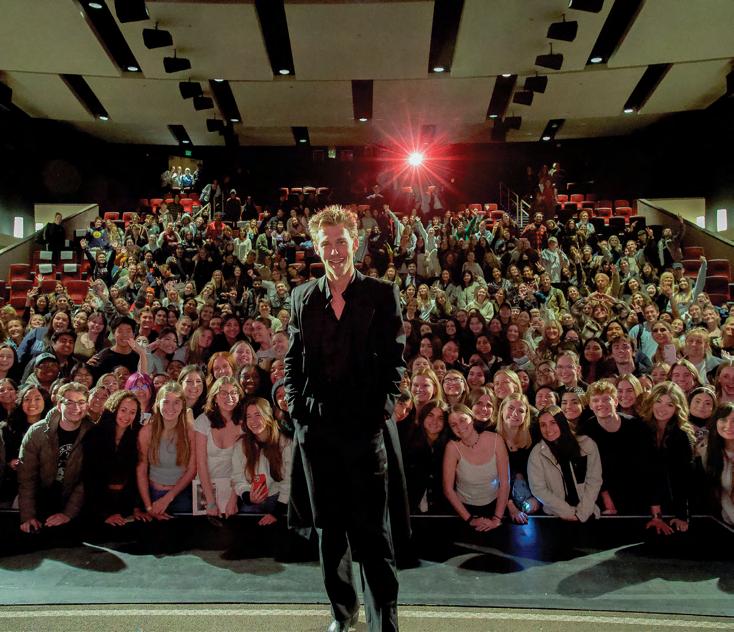
What better way than to bring to campus the creators of Hollywood’s most invigorating work?

The latest lineup of Dodge master classes certainly fulfilled that vision, featuring inspiration from a host of groundbreaking filmmakers, including Oscar winners and nominees.



The storytelling was compelling …
From Brendan Fraser (Best Actor, “The Whale”) and Michelle Yeoh (Best Actress, “Everything Everywhere All at Once”).
From Austin Butler (nominee for Best Actor, “Elvis”) and Todd Field (nominee for Best Director and Best Original Screenplay, “Tár”).
From one of The Daniels – writer-director Daniel Scheinhert (Oscar winner for “Everything Everywhere All at Once”) – and the guy who co-created The Dude – four-time Oscar winner Joel Coen (“The Big Lebowski,” “Fargo,” “No Country for Old Men”).
Here are images and insights from a truly masterful season.
 Above: Austin Butler spends a moment with students; Brendan Fraser joins in a Q&A moderated by Scott Feinberg, Chapman trustee professor and executive editor of awards at The Hollywood Reporter.
Left: Ke Huy Quan, Todd Field, Joel Cohen and Deborah L. Scott share insights and smiles during a standout season of master classes at Dodge College.
Above: Austin Butler spends a moment with students; Brendan Fraser joins in a Q&A moderated by Scott Feinberg, Chapman trustee professor and executive editor of awards at The Hollywood Reporter.
Left: Ke Huy Quan, Todd Field, Joel Cohen and Deborah L. Scott share insights and smiles during a standout season of master classes at Dodge College.
UP FRONT
“PERSONALLY, I DON’T BELIEVE IN BREAKING AN ACTOR DOWN AND BUILDING THEM UP. … IF YOU’RE GOING TO BE AN ACTOR, YOU’VE GOT TO COME WITH THAT VULNERABILITY.”

- COLIN FARRELL
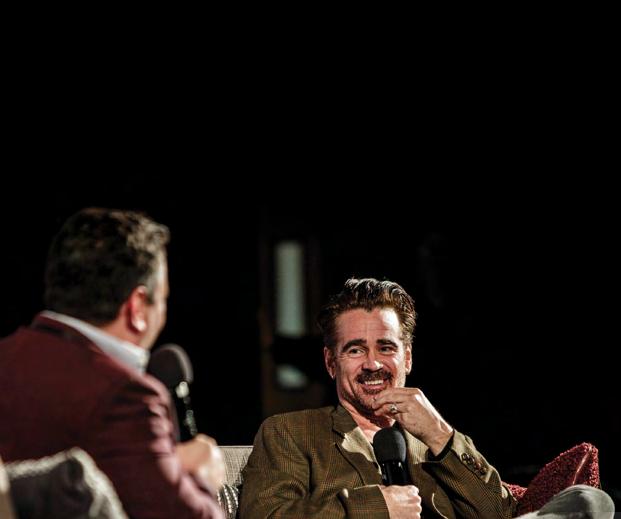
“I WANTED TO GO TO FILM SCHOOL TO LEARN MORE, AND THANK GOD I DID, BECAUSE MY PERSPECTIVE EXPANDED. TO THIS DAY, WHEN I WALK ON A SET, I SEE EVERYBODY.”
“ACTING IS SUCH A STRANGE THING. TO NOT BE INCREDIBLY SELF-CONSCIOUS IN FRONT OF A CAMERA IS HARD.”
- AUSTIN BUTLER

“THE FILM, IN MANY WAYS, IS ABOUT THE BIASES WE HOLD TOWARD PEOPLE WITH OBESITY. … HOW WE SPEAK TO ONE ANOTHER AND ABOUT ONE ANOTHER HAS A LASTING EFFECT ON MENTAL HEALTH.”
- BRENDAN FRASER, ON “THE WHALE”
“THERE WILL ALWAYS BE DOUBTS IN MY MIND – I’VE LEARNED TO ACCEPT THAT. I FINALLY GOT TO A PLACE WHERE I’M HAPPY WITH IT.”
- DAMIEN CHAZELLE

“THANKQ TO MY SWEET DEAR FRIENDS AT DODGE COLLEGE AT CHAPMAN UNIVERSITY!! LOVED SPENDING AN EVENING WITH U ALL! … THKQ TO ALL THE STUDENTS WHO MADE THE NITE SO SPECIAL FOR ME!!”

- MICHELLE YEOH, IN AN INSTAGRAM POST
 - KE HUY QUAN
- KE HUY QUAN
“THE VIOLENCE IS ONE PIECE OF NADIA’S LIFE; IT’S NOT HER WHOLE LIFE.”
- LISA LEITZ
THROUGH A LENS OF HUMANITY
BY DENNIS ARP
EXPLORING PEACE STUDIES THROUGH DOCUMENTARY FILM, CHAPMAN STUDENTS FIND NEW POWER IN THE LIFE STORY AND GLOBAL ADVOCACY OF NOBEL LAUREATE AND PRESIDENTIAL FELLOW NADIA MURAD.

10 | CHAPMAN UNIVERSITY MAGAZINE
As a broadcast journalism student and documentary filmmaker, Tess Martinelli ’24 knows her way around an oncamera interview. Still, it’s not every day that she gets to sit down with Nobel Peace Prize Laureate Nadia Murad.


“Initially, the idea of interviewing her was a bit overwhelming,” Martinelli acknowledged. “But after meeting her, my nerves immediately settled. She’s so amicable and charming, with so many thoughtful insights.” Since last summer, when Murad began a threeyear appointment as Presidential Fellow in Peace Studies at Chapman University, the global human rights advocate has been sharing her experience with Chapman students across the university. This spring, Martinelli and 18 classmates got to engage even more profoundly with Murad in the course “Unsung Stories and New Expressions: Making Conflict-Related Sexual Violence Visible.”
Nobel Peace Prize Laureate Nadia Murad is a Chapman Presidential Fellow in Peace Studies and the first UN Goodwill Ambassador for the Dignity of Survivors of Human Trafficking. Her best-selling memoir, “The Last Girl: My Story of Captivity, and My Fight Against the Islamic State,” recounts her imprisonment and escape during a period of genocide against the Yazidi minority in Iraq. As founder and president of Nadia’s Initiative, she advocates globally for survivors of sexual violence.
“I want to be the last girl in the world with a story like mine,” she says.
SUMMER 2023 | 11
“SHE’S SO AMICABLE AND CHARMING, WITH SO MANY THOUGHTFUL INSIGHTS.”
- TESS MARTINELLI ’24
As the students explored the work of Nadia’s Initiative, which assists survivors and lifts communities out of crisis, they also broke into small groups to create four documentaries that support the initiative and the international cause of eliminating conflict-based sexual violence.
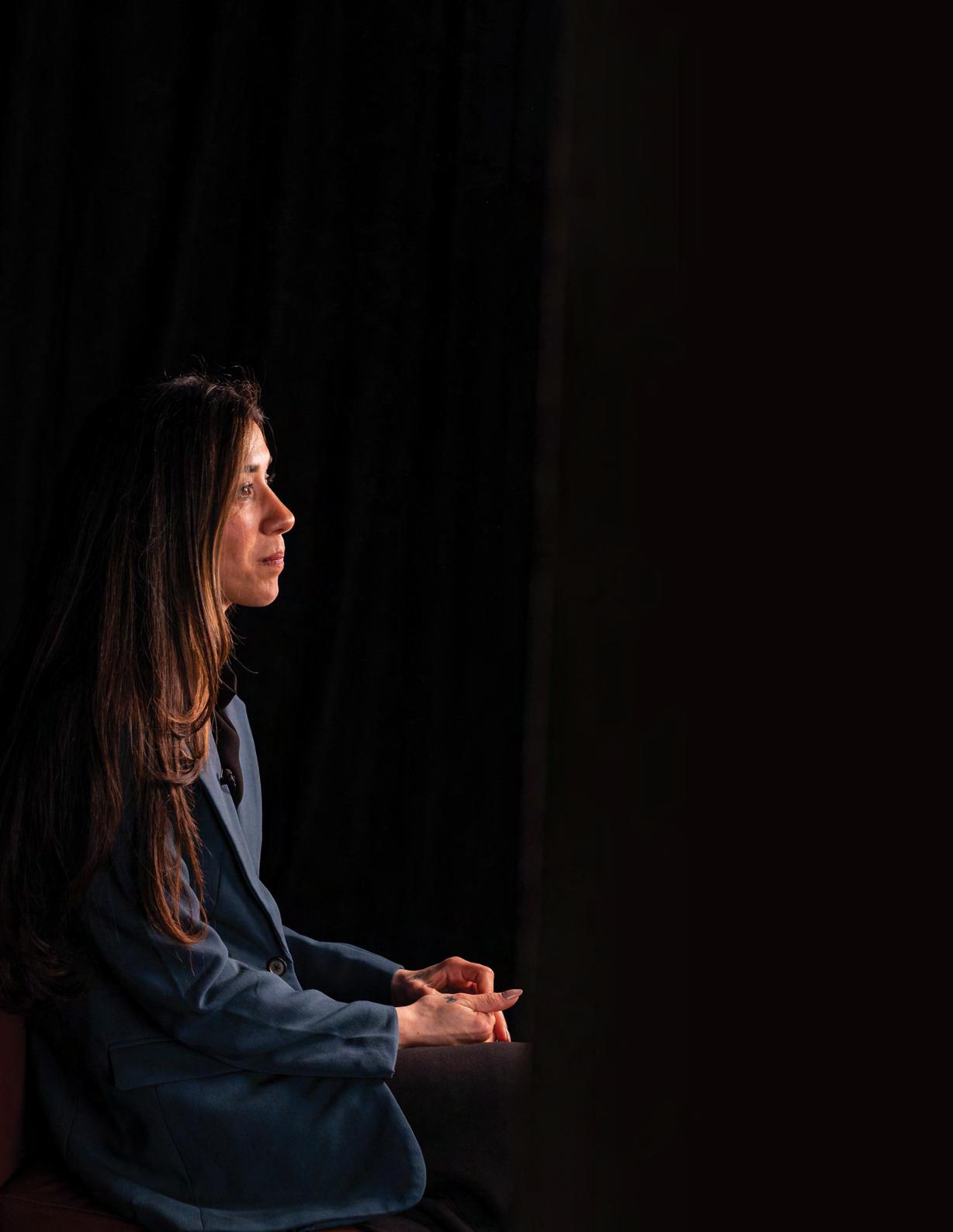
But those short films are just one example of the course’s lasting impact, participants say. Over the semester, the students also learned:
How to turn immersive research and extensive preparation into intensely meaningful storytelling.
How the perspective of peace studies majors can enhance the work of documentarians, and vice versa.
How following the Murad Code of ethical interviewing and conduct can illuminate experience without evoking previously documented trauma.
How survivors of sexual violence have much more to offer the world than just retelling stories of the horrors they endured.
“It’s a chance to consider why we have tended to focus on the violence instead of on the work Nadia is doing to support her community and other women,” said Lisa Leitz, associate professor and Delp-Wilkinson Endowed Chair in Peace Studies. Leitz co-taught the course with Christine Fugate, assistant professor of film and an award-winning documentarian.
“The violence is one piece of Nadia’s life; it’s not her whole life,” Leitz added. “Our students have been able to see how [not understanding that distinction] does a disservice and to apply what they’ve learned.”
“Combining the social sciences with issues like informed consent and how you portray a subject is so important,” Fugate noted. “Really the only way you can understand it all is through experience.”
12 | CHAPMAN UNIVERSITY MAGAZINE
“IT’S A CHANCE TO CONSIDER WHY WE HAVE TENDED TO FOCUS ON THE VIOLENCE INSTEAD OF ON THE WORK NADIA IS DOING TO SUPPORT HER COMMUNITY AND OTHER WOMEN.”
- LISA LEITZ
One student documentary team had a particularly immersive experience, shadowing Murad throughout a week at Chapman. They went backstage as she prepared for a discussion with President Daniele C. Struppa at Musco Center for the Arts; they recorded her interactions with students during classes; and they joined her at home as her husband, Abid Shamdeen, whipped up a traditional Yazidi brunch.

“We learned that she still has dreams she’s had all her life,” said Ruthie Weeks ’25, a broadcast journalism and documentary major. “She loves doing hair and makeup and spending time with friends, just as she’s passionate about her advocacy.”
“We wanted to help her create something authentic to her,” added peace studies major Emma Drake ’23. “We didn’t want
to portray her as a victim who doesn’t have power, because she does, and that’s what matters. Then other people can feel empowered to spread that message.”
Among those people are 19 Chapman film and peace studies students who, during a semester of intense study and collaboration, got to know Nadia Murad better than they ever could have imagined.
Instead of the heroic character they’d read about in some media portrayals, the students met a real person, which makes Murad’s impact all the more tangible, perhaps even attainable, said Blair Henry ’26.
“I feel like we have a lot in common,” Henry said as the team’s week with Murad concluded. “I’m going to miss her.”
SUMMER 2023 | 13
“WE DIDN’T WANT TO PORTRAY HER AS A VICTIM WHO DOESN’T HAVE POWER, BECAUSE SHE DOES, AND THAT’S WHAT MATTERS.”
- EMMA DRAKE ’23
BY DENNIS ARP

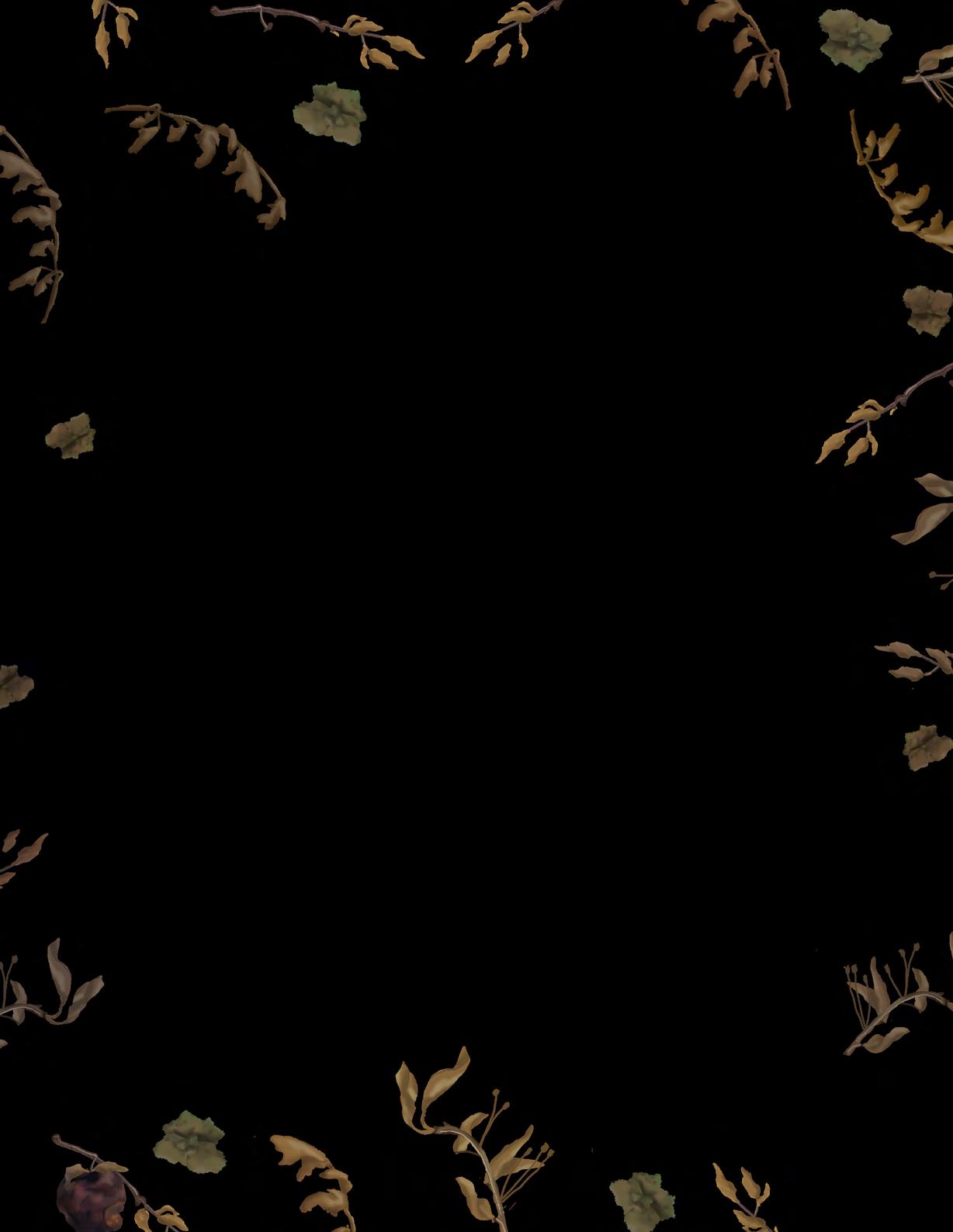

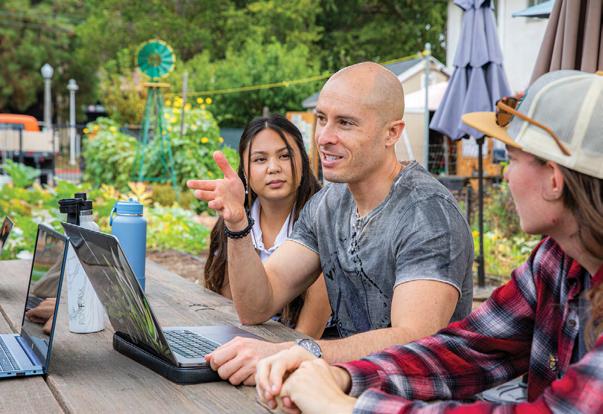

I T’S A L L DA N C E
 BY STACE DUMOSKI
BY STACE DUMOSKI
FOR 30 YEARS, CHOREOGRAPHER DWIGHT RHODEN HAS BEEN EXPLODING BOUNDARIES AND CREATING SOME OF THE MOST DYNAMIC WORKS IN THE WORLD OF CONTEMPORARY BALLET.
90º 90º 90º 40º

SUMMER 2023 | 19 120º 60º 90º y x 180º 120º
“FIVE, SIX, SEVEN, EIGHT …”
Abreathy voice murmurs the count as a dozen dancers move in unison across a studio at Chapman University. The only other sound is the whisper of leather soles over the smooth floor, punctuated with an occasional wooden “thunk” when the rigid point of a toe shoe hits the ground.
A wall of mirrors reflects the dancers’ movements back to them, making them both performers and audience. The people that look back are a mix of skin colors and body types, uniform only in their diversity.

They practice a dance that blends the familiar forms of classical ballet – arabesques, pas de bourrées, grand jetés – with an unrestrained freedom of movement that honors tradition but breaks it apart at the same time.
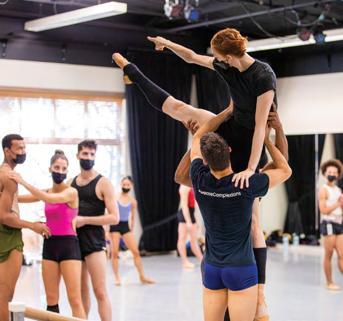
Between the mirrors and the dancers sits the choreographer. His expression is hard to read –like all the dancers, he is masked, part of the newnormal of our post-pandemic world – but his attention is sharp, watching as the dancers bring the product of his imagination to life before his eyes.
Someone presses play on the stereo. A rock anthem blares out. “Boogie,” the choreographer instructs.
 Choreographer Dwight Rhoden observes as dancers from Complexions Contemporary Ballet practice a dance that will be performed to the music of rocker Lenny Kravitz.
Choreographer Dwight Rhoden observes as dancers from Complexions Contemporary Ballet practice a dance that will be performed to the music of rocker Lenny Kravitz.
Dwight Rhoden is one of the newest faculty members in Chapman’s Department of Dance, but today he is working with professional dancers, not students. His company, Complexions Contemporary Ballet, has come to Chapman from New York to perform at the Musco Center for the Arts and to participate in a weeklong Leap of Art residency that will include master classes, lectures and other learning experiences for Rhoden’s Chapman students.
Rhoden has been a choreographer for more than 30 years, from the time he was a young dancer himself, making up his own routines and performing them in competitions. In 1994, he and Tony Award-nominee Desmond Richardson founded Complexions, backed by a vision that would transform the world of dance.

“It was just going to be a project,” Rhoden says. “We invited our friends from all the major companies around New York and some people who weren’t in companies but whose dancing we really loved.” The group included classical ballerinas as well as performers skilled in other dance forms, including modern, jazz, commercial and hip-hop.
At the time when there were hard lines between different styles of dance, “we brought it all into one room and made a show,” says Rhoden.
Each of the performers had a different story, a different background, a different approach, and in the process of making the show, Rhoden and Richardson realized that what they loved about it was the beauty of all those differences.
“We looked at each other and said, you know, this is so beautiful, and there’s a bigger, deeper message of unity with this. Removing boundaries between styles leads to the understanding that we are all different,” says Rhoden.
Removing boundaries would become the core value of Complexions Contemporary Ballet, a critically acclaimed and award-winning dance company that has performed in venues around the world. Not only does the company incorporate many styles of dance, but the dancers also represent different ethnicities, heights, body shapes and dance backgrounds, proving the company’s commitment to diversity, equity and inclusion long before that was an everyday term.
“I always thought that dance is dance. It’s all dance, and we were inspired by the contrast,” says Rhoden.“I become richer inside, knowing someone that is very different from me, and has a different background. It brings a wealth of knowledge and exposes me to something that I might not know, and that is why Complexions exist to this day.”
“Removing boundaries between styles leads to the understanding that we are all different.”
– DWIGHT RHODEN
The Complexions dancers don’t move like most ballet dancers. In classical ballet, the body is held very upright, or “on center.” Precise movements that emphasize the long lines of the dancer’s body are executed with strict adherence to technique. It is graceful yet rigid, structured by rules and tradition.

But contemporary ballet stretches the boundaries of the traditional form. Bodies crumple into themselves one moment, reach outward the next, torsos and limbs hyperextended, expanding to occupy a space for an instant before, on the next beat, pivoting away to fill another. It is the deconstruction of classical ballet, the forms pulled apart but not discarded (as they are in modern dance), instead reassembled into something new. Fluid, energetic – it is the movement that matters, not the pose.
“We had a vision for really investigating and exploring other ways to take the classical form and build it out and go further with it,” says Rhoden. “Sometimes it’s as if we disrupted – which is a strong word – but we disrupted the classical form. Not in a violent way or a derogatory way –it’s more about looking at what the possibilities are with the body.”
Each performance is a fusion of elements – street dance, modern movement, jazz movement. “But all in the frame of a classical foundation that is morphing and evolving into other things,” he says.

22 | CHAPMAN UNIVERSITY MAGAZINE
In the studio, the Complexions dancers have moved on from learning basic steps to blocking their positions on the stage. The ballet they are learning is titled “Love Rocks” – first performed in 2020, but the company will bring it back to the stage this year.
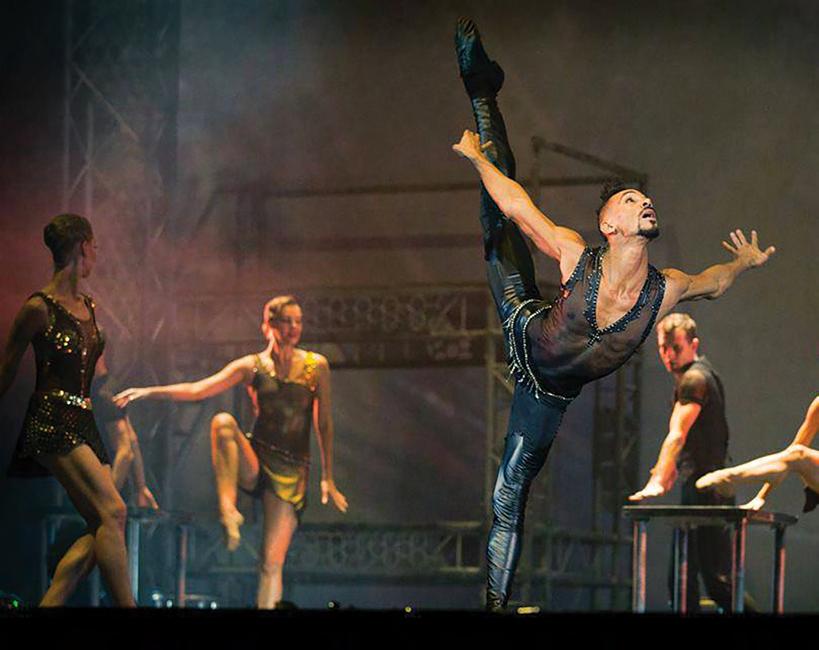
“Sometimes it’s the music that I really like,” says Rhoden, discussing the inspiration for his creative work. “And sometimes it’s a subject matter. There’s something I really want to talk about … or sometimes it’s about what the artists need for their development, or what our audience might have an appetite for. So, it comes in different ways.”
With “Love Rocks,” Rhoden’s inspiration is the music of Grammy-winning rockstar Lenny Kravitz.
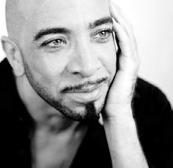
The two met at Paisley Park, where Rhoden was working on a show with Prince. Kravitz, who was going to open the show, asked Rhoden to choreograph his version of the song “American Woman” for the stage performance.
“It is a piece that kind of deals with the idea of love, which is really what Lenny writes about,” says Rhoden about “Love Rocks.” “Anybody who knows me knows that I’m still a romantic. I still think that love can save the world. That might be a little naive of me, but I’m happy to stay in that naive space, because I still really think that therein lies the answer – in unity.”
Founded
“I still think that love can save the world. That might be a little naive of me, but I’m happy to stay in that naive space, because I still really think that therein lies the answer – in unity.”
– DWIGHT RHODEN
SUMMER 2023 | 23
in 1994, Complexions represents one of the most recognized, diverse, inclusive and respected performing arts brands in the world.
Once he starts thinking about an idea, Rhoden starts listening to music. And he writes – poetry, prose, notes about how he wants to move people around on the stage – trying to capture his idea in words before heading into the studio where he’ll begin experimenting with movement.
“I’ll experiment on myself, but I will also bring in a dancer or two and start to work on their bodies, just to generate some ideas and direction,” he says. “The dancers are everything. They are the beginning and the end to what we come up with.”

While he doesn’t expect dancers to make up the steps, he does ask them to collaborate on a certain level, experimenting and exploring together as the dance takes shape. “I never pretend I have all of the best ideas. Walking into the studio, I try to make sure that I remain a bit open, so that I can see what the possibilities are, because sometimes things happen in the studio and you’re like, Wow! I never thought of that, but this is really cool. You have to sometimes get out of your own way.”
Rhoden doesn’t think about dance in terms of “innovation.” For him, honesty is a firmer touchstone for his creative process.
“What I work on a lot is: How is this accessible? How will the audience take it in? Will it reach them? Will they feel what I want them to feel?” he says. “Innovation for me is being honest in your approach and looking for creative ways to say what it is you’d like to say.”
The dancers are intrinsic to that part of the process.
“There are many ways to express, say … love. How can we do this in a fresh and inspiring way? So, I really look at the inspiration as well the process as we’re making something new. Then I think innovation will come,” he says.

“Innovation for me is being honest in your approach and looking for creative ways to say what it is you’d like to say.”
24 | CHAPMAN UNIVERSITY MAGAZINE
– DWIGHT RHODEN
In addition to using his voice to direct the dancers, Rhoden sometimes huddles with them around a computer screen to watch a video of an earlier performance – modern tools for a modern art form – and then they’re back on the floor, twisting their bodies into positions that should be impossible, but are somehow made to look effortless.
Sometimes, he joins the dancers on the floor, demonstrating not just the steps he wants them to take, but the emotion he wants them to convey through their bodies. “We must all unite,” sings Lenny Kravitz through the studio speakers, as the dancers scatter across the floor, only to come together again, fused in a single force of balletic unity.
“I like being connected to the young people,” says Rhoden, thankful for the opportunity to guide students on their way into professional dance careers. “I think one of the biggest surprises is the amount of dedication and the work that it takes to actually do it,” he says.
He doesn’t take anything for granted when it comes to being a choreographer or a director.
“I know that it is a privilege to be able to do it, and to be able to bring your ideas to a group of people and for them to present your ideas on stage. That’s a privilege,” says Rhoden. “I’m grateful for it, and I still love it.”
Dance students at Chapman will benefit from Rhoden’s expertise as a physical storyteller, and from his decades as a dancer, choreographer and director. Students will even have the opportunity to learn some of the Complexions repertory.
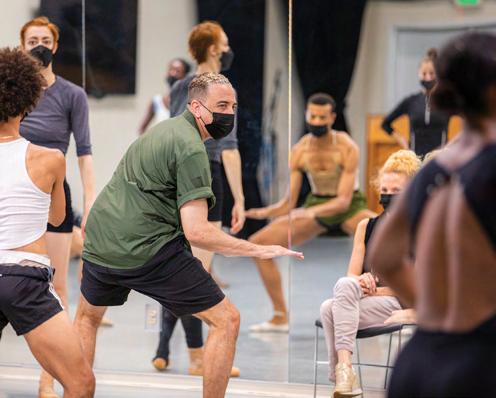

Julianne O’Brien Pedersen, chair of the Department of Dance at Chapman, says, “He brings a whole new understanding of ballet to our students. He works from a contemporary ballet perspective versus a traditional ballet perspective, and both are equally valid, and it’s good for our students to have that variety.”

“We’re not here to judge. We are here to love. There’s no room for hate. We are just one human race.”
“I know that it is a privilege to be able to bring your ideas to a group of people and for them to present your ideas on stage. That’s a privilege. I’m grateful for it, and I still love it.”
SUMMER 2023 | 25
– DWIGHT RHODEN

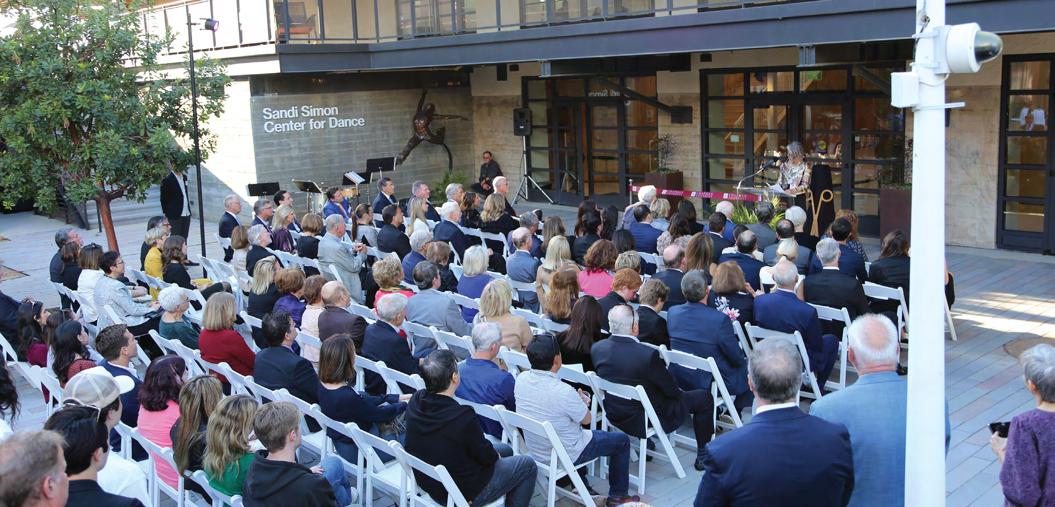





SUMMER 2023 | 29
BY DENNIS ARP


“I’m having this incredible life-changing experience.
I want this to be my life.”
30 | CHAPMAN UNIVERSITY MAGAZINE
– Ben Rotenberg ’23
IN CHAPMAN’S NEW DINO LAB, STUDENTS LIVE OUT CHILDHOOD DREAMS AS THEY BRING TO LIGHT A 78 MILLION-YEAR-OLD FOSSIL FIND.
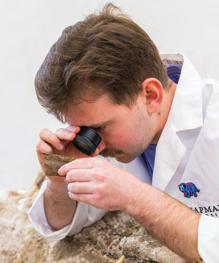
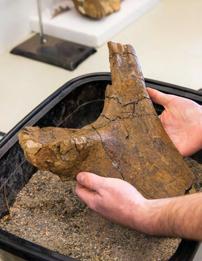
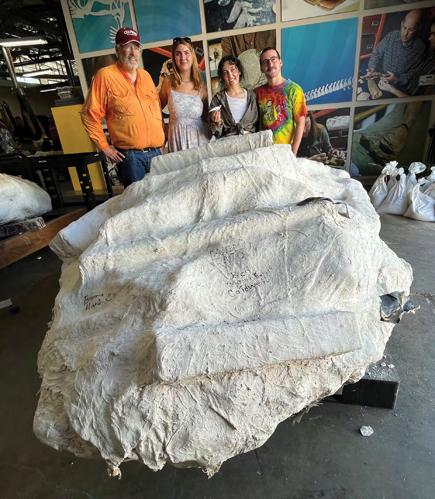
At some point all kids go through a dinosaur phase. Ben Rotenberg ’23 pretty much started his at birth.

Family photos show him playing in a crib packed with dinosaur toys; in other snapshots, he’s wearing a dinosaur onesie or has his face halfway buried in a dinosaur birthday cake.

Alas, Rotenberg’s longings for a life full of prehistoric adventures didn’t survive his childhood.
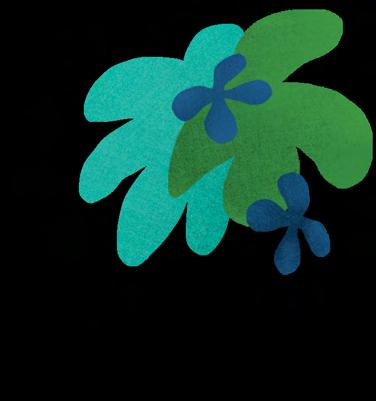

Or did they?
“You get to a certain age and the idea of studying and actually working with dinosaurs seems so unattainable,” said Rotenberg, a senior at Chapman University. “But now, here I am working with this fossil discovery, and I’m having this incredible life-changing experience that I want to continue when this project is finished. I want this to be my life.”
Far surpassing “Jurassic Park” dreams, Rotenberg and fellow students Amalie Seyffert ’23 and Molly Steavpack ’24 are fulfilling some Late Cretaceous aspirations. In a first-floor lab at Hashinger Science Center, they’re bringing to light the fossilized remains of a Gryposaurus, a 40-foot-long genus of duckbill that roamed the then-swampy Badlands of Montana 78 million years ago.
None of the students started their Chapman Experience expecting to dig into paleontology – Rotenberg is studying screen acting and Seyffert documentary filmmaking, while Steavpack is majoring in English literature. But they’ve all found that Chapman is a great place to explore new fields, develop new communities and take up new challenges.
“It’s like doubling down on science learning for someone like me, who’s never felt drawn to the more typical forms of science education,” said Seyffert, an Honors Program student who’s working on a documentary about the project. “To have this hands-on experience with paleontology and the science discipline every day is immensely fulfilling.”
Ben Rotenberg’s childhood fascination with dinosaurs has evolved into lab expertise and career aspirations.
SUMMER 2023 | 31
Professor Jack Horner, left, and students Amalie Seyffert ‘23, Molly Steavpack ‘24 and Ben Rotenberg ‘23 greet the jacketed Gryposaurus fossil specimen as it arrives in Orange County.
LEGENDARY PALEONTOLOGIST LEADS FIELD WORK IN MONTANA


The work started last summer, when the three were among a larger student contingent that traveled to Montana to join in field research led by Professor Jack Horner. Since 2016, the legendary paleontologist has been a presidential fellow at Chapman, where he teaches an Honors course that takes students inside his breakthrough thinking.
Ultimately, after lots of strategizing and teamwork, the Gryposaurus fossil was freed from a hillside and wrapped in a 4,000-pound jacket of plaster for transportation to Orange County so excavation can continue.
Thanks to a generous donor and the tutelage of Horner, Rotenberg, Seyffert and Steavpack have been applying their new skills throughout the fall and spring in a lab set up just for the project. Working around their class schedules, they peeled away layers to reveal more and more of the Gryposaurus skeleton each day, as they also shared the experience with students and visitors via social media, blog posts and other means.
As they worked, they swung the lab’s double doors wide open and posted a sign of welcome to invite visitors inside so the students could share their journey.
The specimen has told them a lot already, including about the environment the Gryposaurus called home. But the participants and their mentor are left with more questions than answers, which fuels their interest to learn more.
Horner shook up scientific theory when he became the first scientist to prove that dinosaurs cared for their young. Later, he took on the role of paleontology consultant for the “Jurassic Park” film franchise.
During several weeks of fossil prospecting last June, the team revisited a discovery that Chapman student Sarah Wallace ’22 had made the previous summer. That’s when Seyffert and fellow film student Flo Singer ’22 began work on their documentary, which is still in progress.

“This is an unusual specimen – the most puzzling I’ve seen,” Horner said. “We have the whole pelvis, short one bone. And that one bone is the opposite of the pubis, that big flat bone,” he added, pointing to the fossil in front of him. “Usually when you find this part articulated, you find the whole skeleton together. It’s just weird that the tail is missing.”
Finding more pieces to the puzzle is why Horner and the students return to the field each June. This time, they planned to widen the search and include more participants in a project that Horner says will turn into a research paper, with Chapman students among the co-authors.

“We’re working to better our knowledge while also honoring something that doesn’t exist anymore, and that’s special to me,”says Steavpack, examining a mini Gryposaurus with Rotenberg.
“To have this handson experience with paleontology and the science discipline every day is immensely fulfilling,” says Seyffert.
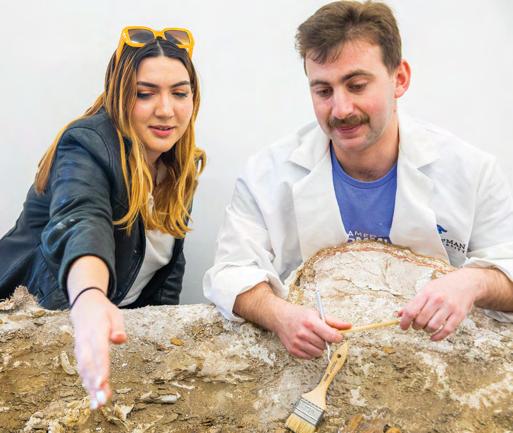
32 | CHAPMAN UNIVERSITY MAGAZINE
Rotenberg isn’t the only one for whom this is a lifechanging experience.

“Being involved in this project has reinforced my appreciation for science as a whole, and for what we can accomplish as a community,” Steavpack said. “We’re working to better our knowledge while also honoring something that doesn’t exist anymore, and that’s special to me.”
PROJECT HAS POTENTIAL TO INSPIRE FUTURE GENERATIONS

Though the fossil excavation is a here-and-now experience, the impact of the find will endure.
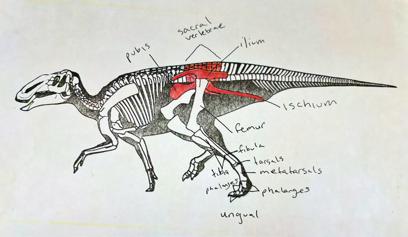
Once all that’s in the plaster jacket is uncovered, the bones will go back on the road. Their ultimate destination is the Burke Museum of Natural history and Culture at the University of Washington in Seattle.

But before the fossils depart, the hope is that they can be scanned and turned into 3D-printed replicas at Chapman’s Fowler School of Engineering. That way the fossil find can continue to captivate and educate Chapman students for generations to come.
“One of the things I try to get across in my classes is that there are great rewards in putting down your phone and taking a good look at the natural world,” Horner said. “You can always go to Instagram and look at a picture of a dinosaur bone, but to see one in person is mindboggling, right?”
Sure, but the fascination wanes after more than six decades in the field, yes?
“I’m as excited to find a dinosaur fossil now as I was as a little kid,” Horner said. “I mean, look at this – don’t you think this is a pretty cool thing?”
Rotenberg didn’t need to answer. He just smiled as he used a dental pick and a paint brush to meticulously remove Montana soil from 78 million years of history.
These days, he has lots of reasons to smile. In the fall, Rotenberg will begin study in a master’s degree program in museology at the University of Washington in Seattle, where he’ll learn about museum collection management and fossil preparation. Who knows, maybe he’ll get to continue his work with the Gryposaurus specimen, since they are headed to the same campus.
As he breaks ground on a new career path, Rotenberg is enjoying every moment of his chance to live out a lifelong dream.
“In my entire life, I never thought I would have an opportunity like this,” he says. “The fascination that began when I was a baby is now opening new avenues. That’s incredibly exciting.”
Scan to see a digital version of this story, including video from the fossil excavation site in Montana and a link to the Dino Lab website.


“I’m as excited to find a dinosaur fossil now as I was as a little kid.”
– Professor Jack Horner
SUMMER 2023 | 33
An illustration posted in the Dino Lab shows which parts of the Gryposaurus skeleton the team has found (in red) and which parts are still to be discovered.
BY LAUREN SIEBERG (MA/MFA ’25)
FEMTOSECOND TECHNOLOGY WILL OPEN DOORS TO EXTREMELY PRECISE RESEARCH BY FOWLER SCHOOL OF ENGINEERING FACULTY AND STUDENTS.
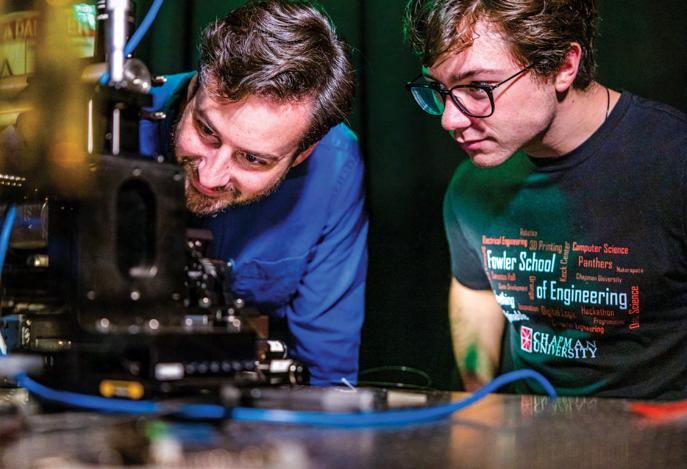
In the Swenson Hall of Engineering Optics and Photonics Lab, students and faculty employ trailblazing technology to explore the vast world of digital information processing. Starting in fall 2023, the lab will introduce an invaluable tool to the Fowler School of Engineering community: a cutting-edge femtosecond laser with real-world research applications, such as in the development of fiber-optic communication systems that use light to transmit information across long distances.
The pulsed laser at the heart of this technology is designed to emit high power over an incredibly short duration – a femtosecond, or onequadrillionth of a second. By shortening each pulse in time, the laser enables users to reach previously unexplored levels of precision in their research.

The femtosecond laser technology will be available to both undergraduate and graduate students.
“This is the type of system that in most institutions, an undergraduate student walks into the lab and is told, ‘You’re not allowed to touch or even breathe on that,’” said Mark Harrison, assistant professor in Fowler Engineering.
Harrison’s research group develops integrated optical devices for digital information processing and optical computing.
“This system is going to be in the same room right next to the stuff my students and I are working on. That proximity and having more students together breeds creative thinking, which is really great for research,” he added.
The new system will join the Optics and Photonics Lab’s current core equipment: two tunable lasers, an optical spectrum analyzer and a waveguide testing setup. With the existing equipment and the new laser system, those trained on the technology will be able to measure spectra through increasingly scaled-down parameters, mix and generate wavelengths, analyze input and output and perform logic and information processing.
A FEMTOSECOND = ONE-QUADRILLIONTH OF A SECOND.
34 | CHAPMAN UNIVERSITY MAGAZINE
Mark Harrison, assistant professor in Chapman’s Fowler School of Engineering, works with electrical and electronics engineering student Matthew Shugarte ’25 in the university’s Optics and Photonics Lab.
INSPIRATION COMES FROM EVERYWHERE.
At Chapman, we drive excellence by fueling curiosity within a community distinguished by an energy of innovation, collaboration and support –on a campus pulsing with intellectual, creative and social vibrance unlike anywhere else.

Since its launch, Inspire: The Campaign for Chapman University has garnered more than $330 million, and more than 16,000 donors have chosen to support our mission to provide personalized education of distinction as we continue our momentum to become one of the most highly regarded universities in the nation. These philanthropic contributions provide capital and academic program enhancements, fund scholarships and financial aid for students, and support the expansion of the endowment, which secures our financial foundation.
To learn more about how the comprehensive campaign is driving the future of Chapman, visit: chapman.edu/inspire.
BY DENNIS ARP
A SCHOOL OF COMMUNICATION PROGRAM BORN IN SARA LABELLE’S CLASSROOM LIFTS UP FIRST-GENERATION STUDENTS AND INSPIRES ONGOING RESEARCH, FORTIFYING A CULTURE OF PRIDE AND PERSISTENCE.

36 | CHAPMAN UNIVERSITY MAGAZINE
Even today, 17 years after Sara LaBelle first set foot on a college campus, her memories of feeling like she didn’t belong are as easy to summon as breath.

“There was a lot of self-doubt,” recalled LaBelle, Ph.D., now an associate professor in the School of Communication at Chapman University. “When you’re a first-generation college student, it seems like everyone else knows what they’re doing and you’re alone – not understanding the terminology or the process of college.”
These days, the chance to demystify that process inspires LaBelle’s research and mentorship at Chapman, where she leads an effort to more effectively communicate with and empower the 18% of CU undergraduate students who are the first in their family to attend college.
LaBelle is collaborating on her research project with faculty colleagues and students who are determined to champion a first-gen culture of “resilience, pride, belongingness and intent to persist to graduation,” as it says in their project summary.
“We’re trying to experimentally test messages that support [first-generation student] culture,” LaBelle said. “We have a really robust first-gen program at Chapman, and the latest class includes the highest percentage of first-gen students [22%] we’ve ever had. So the challenge for all of us becomes, how can we continue to change the narrative for this growing number of first-generation students?”
STUDENT-RUN PROGRAM PROMOTES A SENSE OF BELONGING
That research-driven narrative first started to take shape a year ago, when a class project in LaBelle’s School of Communication course “Advanced Message Design” grew to become a first-gen support program specifically for communication students.
By the end of the fall 2021 semester, the Trailblazer Program was up and running, with tangible benefits to celebrate, including a point-of-pride purple stole that the first class of Trailblazers wore to the end-ofyear School of Comm award ceremony.

“This group of 35 students really met the challenge of creating a new program – a mission statement, program goals, a name, a logo,” LaBelle said. “It’s one of the best classes I’ve ever taught. The students saw that they could have a tangible impact on the school.”
The idea for turning the class into a research project sprang from the way LaBelle saw students reacting to messaging such as is shared via an “I Am a Trailblazer” poster: “I am strong, resilient, admirable, courageous, inspirational.”
Students in Sara LaBelle’s class created the Trailblazer program, including the mission statement, program goals and logo.
 School of Communication graduate Carmen Chavez ‘22 shows off her first-generation Trailblazer stole.
School of Communication graduate Carmen Chavez ‘22 shows off her first-generation Trailblazer stole.
“WHEN YOU’RE A FIRST-GENERATION COLLEGE STUDENT, IT SEEMS LIKE EVERYONE ELSE KNOWS WHAT THEY’RE DOING AND YOU’RE ALONE.”
SUMMER 2023 | 37
- SARA LABELLE
“At the beginning of the semester I had students do some research on the firstgeneration student experience, and as things progressed it got more and more exciting. I found students wanting to be first-gen,” she said.
Instead of distancing themselves from their first-gen status – perhaps even being embarrassed by it – students embraced it.
“We would hold Trailblazer meetings, and students would say, ‘Hey, I’m not totally first-gen, but can I come?’ That inspired me to write this research project – to specify what messages will create this sense of pride for first-generation students, because that’s so important,” LaBelle said.
COLLABORATION ACROSS DISCIPLINES ELEVATES RESEARCH
A $10,000 Chapman faculty grant helped launch the research project, to which LaBelle recruited faculty colleagues Megan Vendemia (School of Comm), Claudine Jaenichen (information design expert in the Department of Art), Stephany Cuevas and Quaylan Allen (both in the Attallah College of Educational Studies with expertise in building programs to support underrepresented communities).
“I basically put together an Avengers team for creating first-generation messages,” LaBelle said with a smile.
First-gen student Erick Cunanan ’23 (MA ’24) has contributed to the research project from its start, eventually becoming LaBelle’s research assistant. He said it was meaningful to collaborate with other students in a peer-driven project, and it was invaluable to participate in workshops with LaBelle and the other faculty mentors.
“I know the struggles, and I really want to uplift first-generation voices on campus,” said Cunanan, a double major in psychology and strategic and corporate communication who is also earning an
accelerated master’s in health and strategic communication. “I feel like it’s my duty and passion to help the community at Chapman.”
‘IT’S REWARDING TO PROVIDE A PLATFORM FOR STUDENTS TO FIND THEMSELVES’

As the inaugural president of the School of Communication Trailblazer Program, Kyle Tanimura ’23 (MA ’24) sees first-hand how the program is connecting with first-gen students. A recent networking workshop he hosted was so well attended that the conversations spilled out of the classroom meeting space and into the lobby of Doti Hall.
Other similarly popular Trailblazer events include a career-focused panel discussion involving firstgen School of Comm alumni, as well as information sessions on internships and study-abroad opportunities for students.
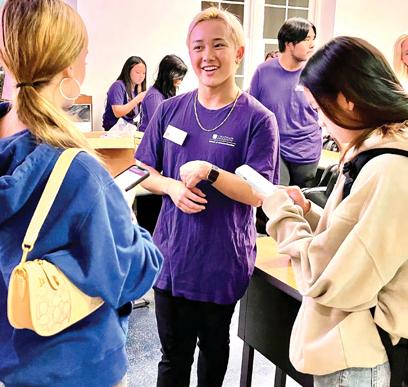
38 | CHAPMAN UNIVERSITY MAGAZINE
Trailblazer President Kyle Tanimura ‘23 (MA ‘24) hosts a popular first-gen networking workshop.
Tanimura is also president of Chapman Kapamilya – a Filipino student club that has helped him connect with his cultural heritage and represent it with pride.
“I want the Trailblazer Program to do that for first-generation students,” said Tanimura, a double major in political science and strategic and corporate communication who is also minoring in dance. “Even though I’m not of first-gen experience, it’s rewarding to provide a platform for students to find themselves.”
“Traditionally, a lot of the messages have been deficit-oriented,” said LaBelle, who is also assistant dean of academic programming and faculty development in the School of Communication.
“It’s not malicious or inaccurate messaging – first-gen students do tend to struggle at universities,” she added. “But what does it look like when we shift the narrative and start calling them trailblazers? What about when we start emphasizing that first-generation students bring something unique to their classes – that they have strengths and resilience and perspective that continuing generations don’t? What if we create something that’s a cool club to be a part of?”
The coolest part of the programming and research effort may be that it’s just beginning, so new insights are likely to keep feeding Trailblazer’s forward momentum.
“For me, the big takeaway from phase one [of the research] is how much better we are together,” LaBelle said. “It’s astounding to sit down with Megan, Claudine, Stephany and Quaylan in a setting where we share ideas and learn from each other. Then, as a first-generation student myself, to feel like I’m making an impact and giving back is also immensely rewarding.”
A NARRATIVE SHIFTS FROM DEFICITS TO STRENGTHS
As Trailblazer also builds bridges to Promising Futures and other university-wide first-generation programs at Chapman, the insights that come from Trailblazer research and experience will continue to bolster an overall culture of achievement, LaBelle said.


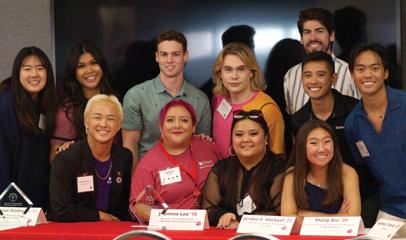
In Trailblazer and beyond, it’s clear that the nuances of first-gen messaging matter.

“AS A FIRST-GENERATION STUDENT MYSELF, TO FEEL LIKE I’M MAKING AN IMPACT AND GIVING BACK IS IMMENSELY REWARDING.”
- SARA LABELLE
SUMMER 2023 | 39
First-gen School of Comm students and alumni gather after a career-focused panel discussion.
BY STACE DUMOSKI
PURSUING BREAKTHROUGH THINKING, CREATIVE AND CULTURAL INDUSTRIES STUDENTS USE A TOOL OF NEUROSCIENCE RESEARCH TO EXPLORE THE POWER OF THE SUBCONSCIOUS.
It’s just a small tent, but the sign on the front that reads “Dream Machine” suggests something big is happening.
Inside is a plastic cylinder attached to a turntable. Users sit with their eyes closed and headphones on, listening to soothing music while the device spins, projecting a shifting pattern of light through holes in the cylinder. During the 20-minute session, most users begin to experience hallucinations. From colored lights to waves to sunlight in a forest, the experience is unique for each participant.

The Dream Machine was constructed by students in professor Patrick Fuery’s Content Creation course, part of the Creative and Cultural Industries (CCI) minor at Chapman University. The Dream Machine is based on a device created by artist Brion Gysin and
mathematician Ian Sommerville in the early 1960s and more recently studied by leading neuroscientists in the United Kingdom.
So how did a group of content creation students end up involved in neuroscience research?
“I honestly had no idea what to expect when Dr. Fuery dropped the project on us,” says Cooper Scott ’23, who is majoring in strategic and corporate communications with a minor in CCI. “This is not something that I would normally do in a typical class.”
The goal of the assignment, according to Fuery, was for students to learn to think outside the box in creating content.
ENTER THE D R E A M M A C H I N E
“I said to them at the beginning of the course, ‘It’s really easy to film a cat falling in a toilet and get 100,000 views.’ Social media is not a hard thing to teach,” says Fuery, who is the founding director of the Center for Creative and Cultural Industries at Chapman. “What is hard is coming up with something that is different, more creative and more informed. More intelligent.”
PROJECT UNITES MULTIPLE CREATIVE INDUSTRIES
The project required collaboration between teams of students on each aspect of the project — construction, music, graphic design and social media.
“It allowed us to explore different avenues of content creation through this one project,” says Rebecca Day ’23, a business administration major with an emphasis in marketing. “We were utilizing so many different kinds of creative industries in one project.”
Understanding how art, design, music and other creative disciplines interact is at the core of the CCI minor, which explores the full range of creative industries such as museums, fashion, film and gaming. The program attracts students from a wide variety of majors including business administration, communications and film, and lays a foundation for creative thinking regardless of career path.
For the students who built it, the Dream Machine became a deep lesson about creativity.
”I had a moment where I realized my brain was showing me this incredible art display that I had virtually zero conscious control over. It was just my subconscious brain feeding me all that stuff,” says Scott, who describes how his hallucinatory experience in the Dream Machine changed his perspective on marketing, messaging and the creative process in general.
“All of a sudden I could see how my conscious brain might interpret a message in one way, but if I showed it to somebody else, what would their subconscious brain tell them?” he says. “There’s a whole side of my subconscious that I can’t tap into consciously. It made me think about ways that I could use that subconscious creativity in a tangible way.”
That, says Fuery, is the main goal of the CCI minor.
“The program gives the capacity to figure out how to be a more creative, divergent thinker – how to take all the things they’re doing in their major or what they want to do in their career and reimagine it in a more divergent way,” he says.
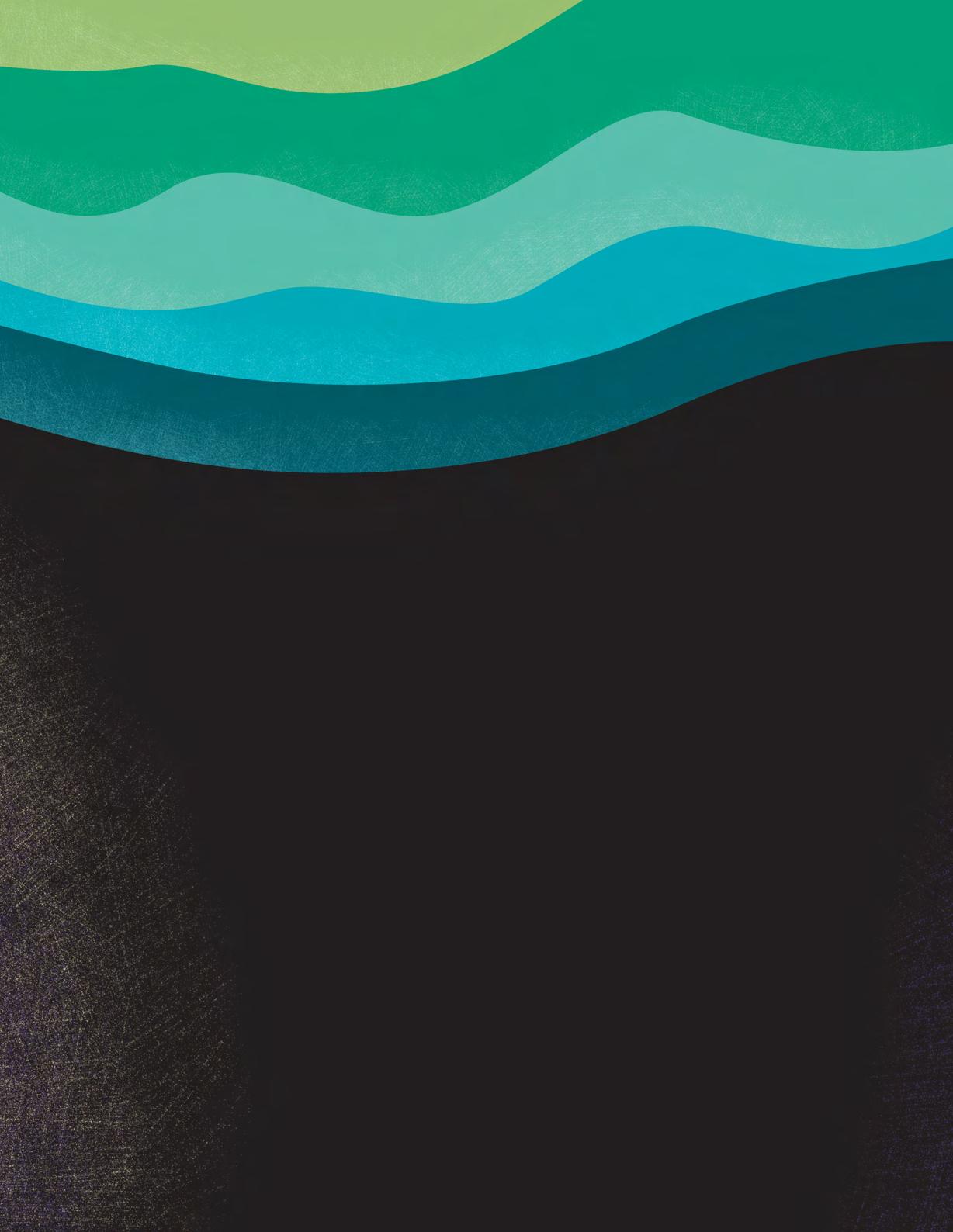
Following the Dream Machine’s popular debut during the Student Scholar Symposium in December 2022, the CCI students presented the device at the 2023 National Conference on Undergraduate Research at the University of Wisconsin-Eau Claire in April.


SUMMER 2023 | 41
Students worked in teams to construct their dream machine based on the original designs of Brion Gysin and Ian Sommerville in the 1960s.
“There’s a whole side ofmy subconsciousthatIcan’ttapinto consciously.
It mad e me think about ways that I could us e that subconscious creativity in a tangible way. ”
- Cooper Scott ’23


“THIS IS ONE OF THE PUREST EDUCATIONAL EXPERIENCES I’VE BEEN A PART OF.”
– Chris Hutchison (Ph.D. ’16)
BY DENNIS ARP
APPLYING 15 YEARS OF PERSPECTIVE, CHAPMAN STUDENTS INVEST THEIR LABOR TO LEARN ABOUT BUILDING RESILIENT COMMUNITIES AFTER HURRICANE KATRINA.
There’s nothing like a purple house to inspire vivid conversations.

In January, as Chapman University students repaired the lavender siding and glazed the glistening windows of Stella Williams’ cottage in the Upper Ninth Ward of New Orleans, passersby often stopped to ask questions about the work, including to inquire how they could help.
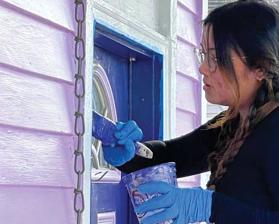
“There’s something about the energy of this city that draws you in and draws you back,” said Loraine Ignao ’24, an integrated educational studies major.
Since their first trip in 2006 to help rebuild lives after Hurricane Katrina, Chapman student volunteers have
been returning to New Orleans almost every January. They bring their venturesome spirit and their vigorous labor as part of a winter Interterm travel course called “Leadership in Times of Crisis: Disaster Response.”
Even in a city known for its vibrancy and resilience, the enduring commitment of Chapman students stands out like Stella Williams’ boldly hued home.
“You can tell that they love the city,” said Kat Schweitzer, communications director for Rebuilding Together New Orleans (RTNO), which since 2005 has completed more than 850 homerepair and community revitalization projects, aiding the elderly, disabled, veterans and others in need.
“I don’t know that I can quantify the impact Chapman has had over the years,” Schweitzer added. “Our team is always excited to have the students here, which is a great sign of their impact. They work hard and they want to get to know the community. I think that speaks to their lasting concern.”
2008 2010 2011 2013 2014 2 015 2016 2017 2019 2020 2022 2023
AFTER A DEVASTATING HURRICANE, A COMMITMENT TO REBUILD
RTNO projects met massive needs immediately after Katrina, but the sounds of hammers and backhoes continue to resonate, reflecting the determination of residents who respond to setbacks by rebuilding in neighborhoods they have called home for generations.
In August 2005, Katrina pummeled New Orleans with 140 mph winds. Storm surge overwhelmed levees and canals, flooding 70% of the city and turning hundreds of thousands into refugees. Ultimately, the city absorbed $140 billion in damage and held memorial services for more than 1,000 of its residents.

Chapman’s first response was organized in the months after the storm, when the Fish Interfaith Center led a service trip to aid in relief. Instructors Chris Hutchison (Ph.D. ’16) and Justin Koppelman ’04 (MA ’09, Ph.D. ’16) launched their Leadership Studies Interterm course two years later.
That was 15 years ago, and new cohorts of students are still responding to the service and learning opportunity.
“As a case study, I don’t think Katrina and New Orleans will ever lose their power,” said Hutchison, associate vice president for student affairs and associate dean of

students. “They continue to offer a rich curriculum of experience.”
In addition to sweat and service, the 10 students’ 10 days in New Orleans feature journeys through the city’s richly diverse neighborhoods as they meet residents and sift through layers of history. Among other things, they learn that the story of emergency response and rebuilding is also multilayered and full of lessons.
LESSONS ON LEADERSHIP AND CREATING CONNECTIONS THAT ENDURE
By consistently returning to the same city over 15 years, the class provides a nuanced look at crisis response through the lenses of social change, servant leadership and relational leadership, Hutchison and Koppelman said.
“It becomes evident to the students how these frameworks connect both when they are present and also in their absence,” Hutchison said. “Katrina sets an underlying tone, but the course shifts to become more about understanding the notion of community and
responsibility – how we treat one another and how important it is to look at things from multiple perspectives.”
The long view brings special insights, the instructors note. Some reconstruction projects that were hailed in the immediate aftermath of Katrina are now failing because of shoddy design or materials. A mayor once seen as standing up to the rigors of emergency response was eventually sentenced to 10 years in prison for wire fraud, bribery and money laundering.
“Throughout the course, we encourage the students to keep an open mind, to not take anything for granted, to do their research and to consider every perspective,” said Koppelman, director of student engagement at Chapman.
As they study the ways a community responds to big challenges, the students develop a rich communal spirit of their own. Most participants don’t know each other when the journey starts, but they quickly develop a camaraderie that carries them through long days of physical labor, intense study and deep thinking.
Eighteen years after Hurricane Katrina, New Orleans residents continue to deal with the storm’s devastating effects.
44 | CHAPMAN UNIVERSITY MAGAZINE
Each January, Chapman students mix learning with labor during the Interterm course “Leadership in Times of Crisis: Disaster Response.”
“Yes, we were 10 different people from different disciplines, and it was like we were thrown together in this travel course, but I came out of it with nine great new friends and nine new connections,” said Anjie Aveno ’24, a health sciences major who’s preparing for a career in emergency medicine. “I’m about to go see them again and have dinner with them and talk about the trip again. So I think that feeling will endure, since we’ve seen each other every day this week and we’re still not tired of each other.”
If the experience of the students’ instructors is any indication, that spirit of collective growth – of “being part of something bigger and better than myself,” as Aveno put it – absolutely will endure.
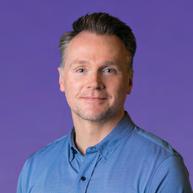

“This is one of the purest educational experiences I’ve been a part of,” Hutchison said.
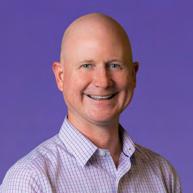
“It’s powerful to see the students’ critical thinking come to life as they navigate complicated situations and issues,” he added. “We observe them as they learn who they are as individuals and as leaders. That sense of community and connection is very real and very fulfilling.”

“WE ENCOURAGE THE STUDENTS TO KEEP AN OPEN MIND, TO NOT TAKE ANYTHING FOR GRANTED, TO DO THEIR RESEARCH AND TO CONSIDER EVERY PERSPECTIVE.”
– JUSTIN KOPPELMAN ’04 (MA ’09, PH.D. ’16)
“THAT SENSE OF COMMUNITY AND CONNECTION IS VERY REAL AND VERY FULFILLING.”
SUMMER 2023 | 45
– CHRIS HUTCHISON (PH.D. ’16)
HAVING A BALL – WITH PHYSICS?
BY DENNIS ARP
Near the steps of Memorial Hall, physics professor John Howell and his students squint into the brilliant sunlight as they try to keep a brightly colored beach ball aloft.

Howell might be able to spin this as a science experiment – after all, drag force, terminal velocity and molecular motion all are in play. But those effects don’t explain why this scholar known internationally for his research on quantum optics decided to inflate a polyvinyl sphere and send it skyward on Bert Williams Mall.
Beyond physics, this exercise breaks the ice with new students, allowing them to quickly learn each other’s names and to view classmates as teammates.
Forget gravity and velocity – this is all about community.
“As the students hit the ball and say their name, barriers fall,” said Michael Ibba, dean of Schmid College of Science and Technology at Chapman University. “It humanizes John as the instructor – as someone his students can trust. Right from the start, they’re more willing to talk with him and ask questions.”
Howell understands that his field of study can be intimidating to non-physics majors such as those in his class “General Physics for the Life Sciences.” So from day one, he wants them to know that he and the class are in this together, and everyone involved has each other’s back.
Howell’s attention to student success comes at a time when across higher education, physics programs are seeing post-pandemic declines in enrollment. Howell and others at Chapman are determined to reverse that trend.
“I love physics, and I want my students to have a chance to love it, too,” the professor says.
Howell came to Chapman last fall, joining the university’s Institute for Quantum Studies. Ibba is grateful that his new faculty member not only brought his lab, his innovation awards and his more than 8,600 research citations, he also brought his enthusiasm for teaching general physics classes.
RENOWNED SCHOLAR JOHN HOWELL WELCOMES NEWCOMERS TO HIS DISCIPLINE BY PUMPING UP THE STUDENT SUPPORT AND DEFLATING WHAT MAKES PHYSICS DAUNTING.
“I love physics, and I want my students to have a chance to love it, too.”
- John Howell
46 | CHAPMAN UNIVERSITY MAGAZINE
“What’s really great is that John has the skill set to show people that physics is interesting and why it’s important to them,” Ibba said. “He makes the experience accessible and immersive.”
Biology major Izzy Dhindsa ’23 admits that she started Howell’s course feeling stressed because she has “never been that great at physics.” But now she enjoys the subject.
“He relates the content to everyday life, which I really appreciate,” she says. “He changed my perspective about physics.”
Howell experienced his own transformation of thinking early in his career.
“I used to look at teaching as a burden because it took me away from my research,” he said. “But now it’s a joy. I like seeing the light come on in their eyes.”
That light didn’t come easily to student Alexis Shiber ’23. She remembers a class session last fall when, as Howell covered a particularly difficult topic, he saw looks of confusion throughout the room. Shiber was among those with a furrowed brow.
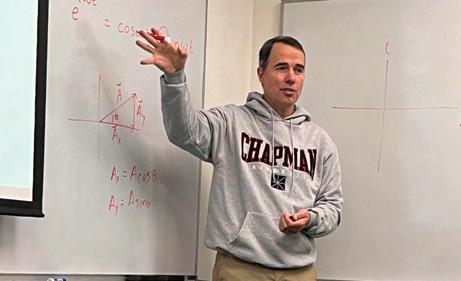
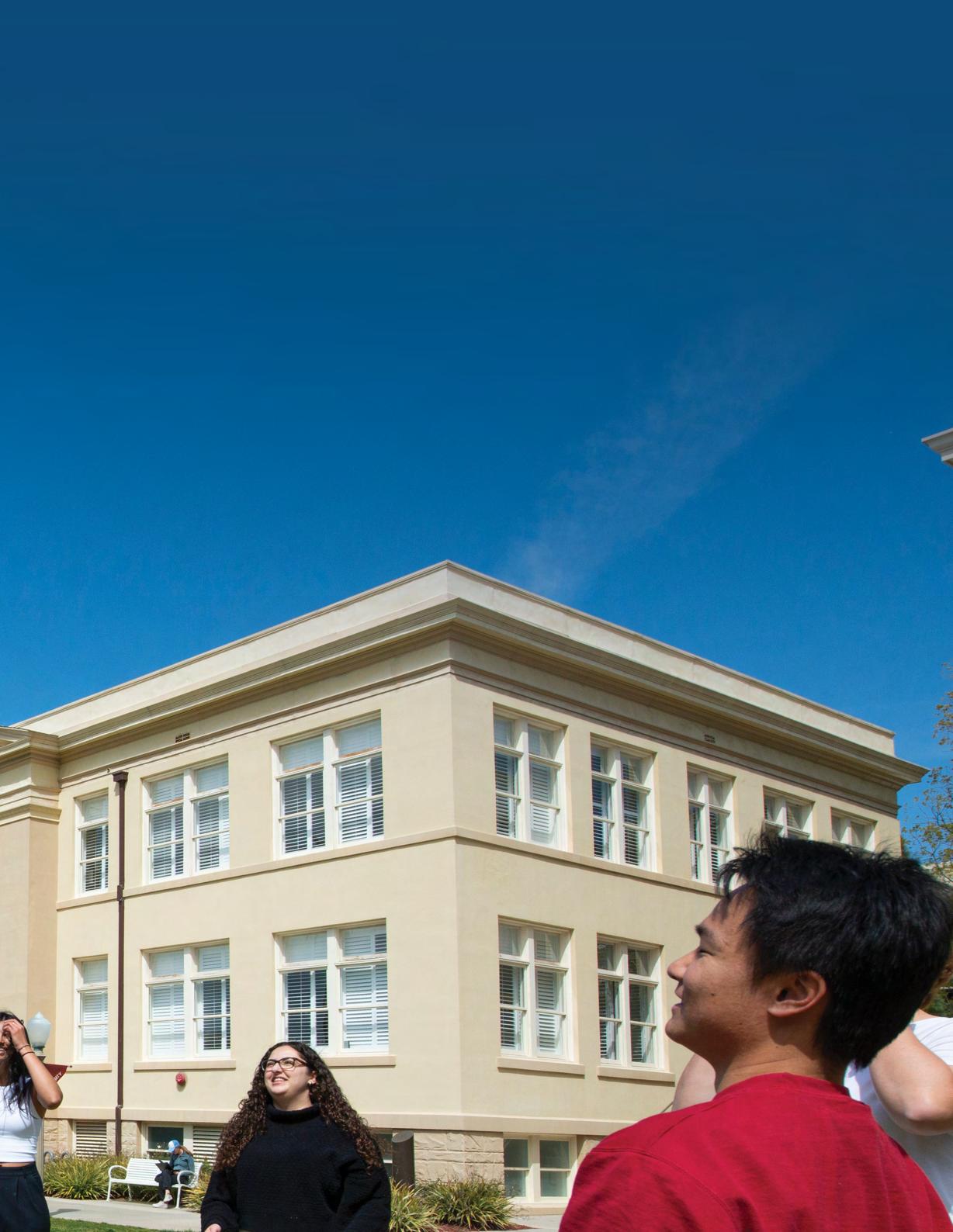
“The next class, he redid that lecture and went into more depth, with different examples to make sure we understood,” she says.
Howell’s concern for students extends beyond the classroom and the academic calendar. Last fall, as the holidays approached, class members received an invitation to join Howell and his family for Thanksgiving dinner, to ensure that no one spent the holiday alone.
“I was in awe when I saw that message,” Shiber says.
Those warm feelings of communal support overshadowed her initial reaction when Howell broke out the beach ball on the first day of class. It was hot out on the lawn, and Shiber just wanted to get back inside with the AC.
“But by the end, I knew everyone’s name. All the faces were familiar, and things felt comfortable,” she says.
As comfortable as classmates who are now friends, and physics concepts that no longer make her sweat.
SUMMER 2023 | 47
SUPPORTIVE COMMUNITY AIDS WITH
BY JOY JUEDES
F our men play a board game, joking and cheering each other on. They compete to name a fruit, an animal, a sport.
The lightheartedness of their interactions contrasts with the reason they’re friends –they each have aphasia.

Aphasia – loss of ability to understand or express speech and language, often caused by brain damage – has been in the news recently because it affects actor Bruce Willis. Unlike Willis, the men playing the board game had limited resources to deal with their stroke-caused aphasia.
Enter Chapman University.
‘A TRUE BLESSING’
The men attend a weekly stroke support group run by graduate speech therapy students in the Adult Learning Lab at Chapman’s Rinker Health Science Campus. The learning lab offers free services for
adults with communication challenges caused by brain injury, stroke and other neurological disorders.

The stroke support group helps participants get comfortable communicating with a special device and gives them a place to interact socially while challenging them to communicate.


A few years ago, Orange residents Cliff and Robin Massingale heard about Crean College of Health and Behavioral Sciences’ stroke boot camp. After attending the camp, Cliff started individual speech therapy at Chapman.
Previously, Cliff didn’t attend formal speech therapy because his medical insurer determined he wouldn’t benefit.
“They were so wrong,” Robin says. “It was a true blessing finding this program as he has improved so much since that time with the wonderful students and staff at Chapman. If not for this program, he likely would not speak much at all.”
THE ADULT LEARNING LAB AT RINKER CAMPUS PROVIDES THERAPY AND CAMARADERIE FOR PEOPLE WITH APHASIA, A SPEECH CHALLENGE CAUSED BY BRAIN DAMAGE.
“IF NOT FOR THIS PROGRAM, HE LIKELY WOULD NOT SPEAK MUCH AT ALL.”
48 | CHAPMAN UNIVERSITY MAGAZINE
ROBIN MASSINGALE
When Mission Viejo resident Richard Purdy had a stroke 10 years ago, Chapman was the only place his wife, Patricia, knew of in Orange County that offered free speech therapy. Richard is now a regular member of the group.
“We have people here who would never get therapy if they didn’t come here, because they don’t have insurance for it,” says Clinical Assistant Professor Lisa Lachance, who oversees the Adult Learning Lab. “And so I get a little soft spot in my heart for that reason.”
The learning lab also offers a book club for people in the community with aphasia. They meet online each week to discuss a book and have access to “reading ramps” – a bulleted summary of each chapter – and worksheets for levels of ability.


“The idea is that by slowly increasing their participation, it decreases their disability,” says Zina Rhee, a lecturer in Crean’s Department of Communication Sciences and Disorders who started the group.
SUPPORT AFTER STROKE
Speech therapists evaluate a person recovering from a stroke, then work on speaking, writing, hearing and reading comprehension if the stroke affected their brain’s left hemisphere.

“We do different activities helping them to be able to find the words so they know what they want to say if they can’t get the word out,” Lachance says.
In the group, learning lab supervisors and students teach people to use a tablet device programmed by a company called Lingraphica. Tablets can be customized with photos and names of people the person knows. Medicare pays for the devices.



“He’s learned quite a bit about using the device,” says Orange resident Toni Colombo, whose husband, Joe, has attended the group for a year and a half. “He’s become more attentive – he watches everyone and it has helped people other than family members communicate with him.”
Much of that progress is because of the graduate students who run the group as part of their clinical training. Sarah Nabhani (MS ’23), who ran the group with another student in the fall semester, says she has gotten to work with a variety of people.
“The participants are so different, yet collide for one main objective –communication,” she says.
Beyond the therapeutic benefits, the group “gives everyone a way to have fun and to laugh,” Patricia Purdy says.

Lachance likes to tell the story of Joe Colombo practicing his speech for his daughter’s wedding.
“He stood up there so proudly and everyone in the place was crying,” Lachance says. “They recorded it and we watched it – we were all crying. Speech therapy gave him the confidence to stand up there and do that.”
“THE PARTICIPANTS ARE SO DIFFERENT, YET COLLIDE FOR ONE MAIN OBJECTIVE–COMMUNICATION.”
SARAH NABHANI (MS ‘23)
Speech therapy graduate student Sarah Nabhani (MS ‘23) plays a game with participants at the Adult Learning Lab’s stroke support group at Rinker Health Science campus.
SUMMER 2023 | 49
Sarah Nabhani (MS ’23) helps Cliff Massingale with his communication device at the Adult Learning Lab’s stroke support group at Rinker Health Science campus.
FROM STOCKHOLM TO CHICAGO, MIAMI TO THE METAVERSE, HENRIK CRONQVIST GOES THE DISTANCE IN DEVELOPING HIS VISION FOR THE FUTURE OF BUSINESS EDUCATION.
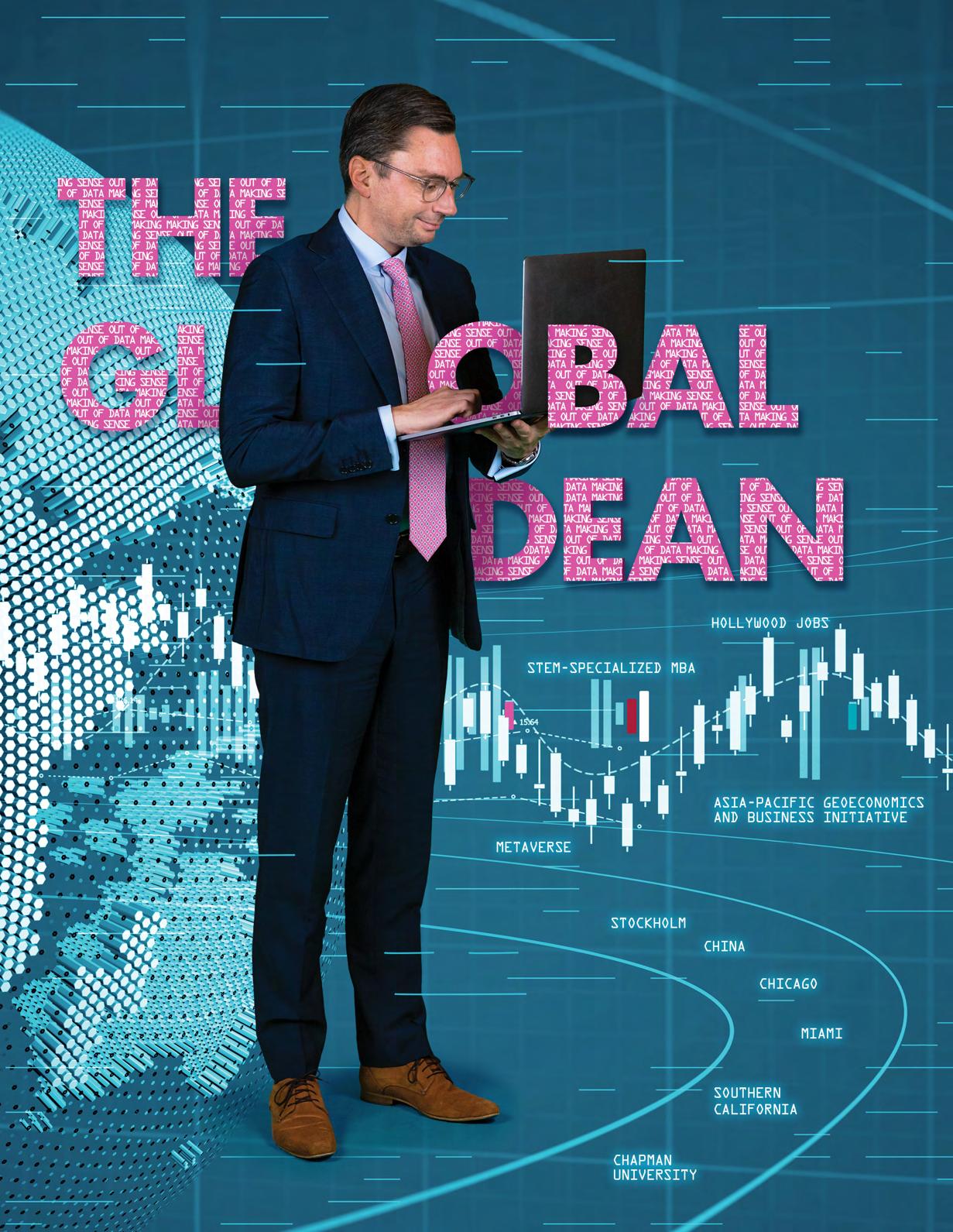 BY JOY JUEDES
BY JOY JUEDES
50 | CHAPMAN UNIVERSITY MAGAZINE
If Henrik Cronqvist’s thoughts were visible, they might look like a live stock index.

Cronqvist has been dean of Chapman University’s Argyros School of Business and Economics for less than a year, and he has already mobilized his vision for business education, meeting industry and leadership demands of the next decade and beyond.
Where to start? Among other things, Cronqvist is adding a “metaverse” executive to the faculty; collaborating with Chapman’s No. 4-ranked Dodge College of Film and Media Arts; meeting demand for data analytics; offering a STEM-specialized MBA; developing a new Asia Pacific initiative.
And that’s just in 2023.
Or, as Cronqvist put it at Chapman’s 45th Economic Forecast in December 2022, “No other business school has progressed as much as this business school in such a short period of time.
“That said, we have our best years ahead of us.”
the school’s own stock index – an idea he brought to Chapman.
“When I joined Chapman, many people told me, ‘Chapman is a hidden gem in Southern California.’ And I said to myself, ‘Why do we hide? What are we hiding from?’” he said.
“So we are going to move from being a hidden gem to just being a gem.”
Cronqvist believes Chapman is prepared for “a leap into the national arena and also the global arena.”
Part of Cronqvist’s vision for that leap includes the metaverse – a still-evolving central virtual world parallel to ours. He appointed an esports and gaming executive as “metaverse executive in residence” who will offer industry panels, career advice and courses at Chapman.
The metaverse – which encompasses all things cyberspace and how humans interact with them – is a multibillion-dollar industry with a range of jobs. Cronqvist said one of Chapman’s career experts was
“We already have good ties with industries, so we’re broadening and deepening those ties,” he said.
Orange County’s rich business landscape includes biotech, health care, finance and entertainment. Locally based corporations like Disney, Pimco and Chipotle already hire Chapman students to help them innovate.
“A lot of these companies are looking to digitally transform themselves, and data has a very important role in that domain,” Cronqvist said.
To meet this exploding demand for data, Argyros will offer a new master’s degree in business analytics. Cronqvist is collaborating with Chapman’s Schmid College of Science and Technology and Fowler School of Engineering for related courses, and for another new Argyros offering: a STEM-certified MBA.

A related collaboration is a new business of entertainment minor, through which he envisions capitalizing even more on Chapman’s proximity to Hollywood.
“Chapman is known for its highly ranked film school, and that’s all some people may know about Chapman, right?” he said. “So this is a concrete example of how we integrate two schools.”
Cronqvist’s own trajectory in business higher education is just as impressive. It led him from his Swedish hometown of 2,500 to the Stockholm School of Economics, then to the University of Chicago, where his doctoral advisor was Richard Thaler, winner of the Nobel Prize in 2017 for his work in behavioral economics.
“Working with him and understanding how he thought about research projects and questions was a defining moment in my career,” Cronqvist said.
After Chicago, Cronqvist taught finance in the Midwest, China and Southern California. He landed at the University of Miami’s business school, where he rose to vice dean and helped implement
recently “inundated” with inquiries about working in gaming and esports.
“There’s a lot of interest among young people for those products, and we’re in an area of the country where this is a very important industry,” he said. “We need to be able to meet demand among our students.”
Cronqvist also emphasized the importance of experiential learning –“that we learn not only in the classroom, but also through projects with real companies, simulation exercises, through team-based education.”
To facilitate that hands-on learning, Cronqvist wants students to work at businesses that provide tools for career success.
Chapman already offers a joint MFA/ MBA program. In November 2022, Cronqvist and Dodge Dean Stephen Galloway interviewed DreamWorks cofounder Jeffrey Katzenberg.
Cronqvist is also looking toward another facet of global business – Asia-Pacific commerce. Argyros’ new Asia-Pacific Geoeconomics and Business Initiative will differ from those at other universities by focusing on the effects of countries’ business policies, rather than the region’s politics or culture.
“There are many aspects of the AsiaPacific region that business leaders would want to understand, and we will fill that gap,” he said.
“I BELIEVE THAT NO OTHER BUSINESS SCHOOL HAS PROGRESSED AS MUCH AS THIS BUSINESS SCHOOL IN SUCH A SHORT PERIOD OF TIME.”
SUMMER 2023 | 51
– Henrik Cronqvist
BEVERLY WEATHERILL
Longtime teacher and Chapman University supporter Beverly Weatherill ’50 passed away Feb. 14. She was 95.
“I would just like to be remembered with love,” she said in a 2020 interview for StoryCorps. Throughout the Chapman Family, there is deep love for Bev Weatherill.
The Rev. Nancy Brink, Chapman’s director of church relations, said Weatherill “breathed Chapman.”
“She told wonderful stories from her days on the original Los Angeles campus, making it come alive,” Brink said.
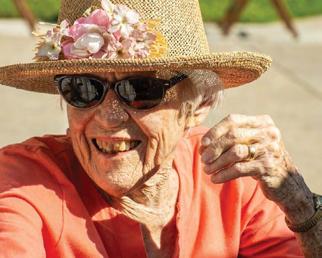
Weatherill taught elementary school for 30 years, choosing the profession in part because of the influence of those who taught her. A self-described introvert, she applied her fifthgrade teacher’s advice throughout her life: “If you’re shy, try to think about making the other person comfortable and introduce yourself.”
“She was genuinely interested in people and making connections with people,” said Essraa Nawar, Chapman Leatherby Libraries diversity and development librarian, who became good friends with Weatherill.

BOB BARRY
Engineer and Chapman University Board of Governors member Bob Barry passed away on March 5, 2023. He was 68.

Chapman President Daniele C. Struppa highlighted the many important contributions of Barry as an avid supporter for the development of Fowler School of Engineering, where he was a dean’s adviser. He began serving on the Board of Governors in 2017.
Barry became involved in Chapman through his daughter, Megan (Barry) Whaley (MA/ MFA ’09). He supported scholarships through Chapman Celebrates and the Economic Forecast. He helped bring the Rev. Greg Boyle, founder of Homeboy Industries,
After Weatherill’s first marriage ended in divorce, she didn’t date for 34 years. Then in 1989, Dave Weatherill ’51 (MA ’66), a recent widower who was part of Bev’s group of college friends, asked her to dinner.
Dave proposed at the end of their first date, and they married six weeks later.
“We had 29 years together, and they were wonderful,” Bev said.
The Weatherills were featured in “150 Faces of Chapman University,” which commemorated the school’s 150th anniversary.
Dave, known as “Mr. Chapman,” was a three-sport athlete, basketball coach, faculty member and administrator. He was inducted into the university’s Athletics Hall of Fame and passed away in 2018.
Bev Weatherill is survived by her children, Christopher, Mark, Lisa and Andrea; many grandchildren, including Lauren Kamp ’08 and Kevin Kamp ’14; and great-grandchildren.
to receive an honorary doctorate from Chapman and to speak on campus in 2021.
Barry was born and raised on Lido Island in Newport Beach. He earned a bachelor’s degree from UCLA and an MBA from Pepperdine University. He joined his father’s engineering firm, John Barry & Associates, in the 1970s.
In 1992, he became president of the firm, for which he led a team of management consulting engineers serving manufacturing and distribution companies.
Barry is survived by his wife, Roberta, daughters Jane Barry-Moran and Megan Whalen, and other family members.
52 | CHAPMAN UNIVERSITY MAGAZINE
IN MEMORIAM
STEPHEN ‘TWITCH’ BOSS
The Chapman Family and dance community continue to mourn the loss of Stephen “tWitch” Boss, who is remembered for his immense talent and “beautiful heart.” Boss died Dec. 13, 2022. He was 40.
“Stephen lit up every room he stepped into,” recalled his wife, Allison Holker Boss. “He valued family, friends and community above all else.”
Perhaps best known for his magnetic presence as DJ on “The Ellen DeGeneres Show,” Boss died by suicide, as reported by the Los Angeles County Medical Examiner-Coroner.
“It is always heartbreaking to lose family, and we are crushed by the loss of a vibrant member of ours,” said Giulio Ongaro, dean of Chapman’s College of Performing Arts.
Boss thrived on “So You Think You Can Dance” and across other entertainment industry platforms, leaving his mark as a dancer, choreographer, actor and producer.
ZELMA ‘ZEE’ ALLRED
Entrepreneur and philanthropist Zelma “Zee” Allred, who served on Chapman University’s Board of Trustees for more than 30 years, passed away Jan. 30. She was 94.

Allred grew her business, Pool Water Products, from a $500 starter loan to the largest woman-owned business in Orange County. She was generous in her support of Chapman, including by funding the Olympic-quality Allred Aquatics Center. In 2009, Chapman awarded an honorary doctorate to Allred, who had left college to raise her two sons.
“Zee exemplified leadership in all its forms and undeniably saw everyone at Chapman as family,” said Chapman President Daniele C. Struppa.
Pool Water Products, headquartered in Irvine, expanded into four other states. The Orange County Business Journal, when awarding Zee its Women in Business Lifetime Achievement Award in 2014, said she grew the company
But before that, he blazed across the stages and studio spaces during his two years as a student at Chapman.
“Dancers are givers of light and energy, and his reach extended far,” said Julianne O’Brien Pedersen, chair of the Department of Dance at Chapman. “To think that he must have suffered as deeply as he touched and inspired gives pause. Our hearts are with his family.”

Many fellow performers took to social media to share their love for Boss.
“I’m heartbroken,” DeGeneres said in an Instagram post. “I loved him with all my heart. I will miss him. Please send your love and support to Allison and his beautiful children – Weslie, Maddox, and Zaia.”
If you or anyone you know is having thoughts of suicide, please call the National Suicide Prevention Lifeline at 988 or go to SpeakingOfSuicide.com/resources.
“while nurturing a family, thereby raising the glass ceiling for women in all workplaces and setting a meaningful example for those who face difficult decisions regarding the balance between family responsibilities and professional life.”
Her community involvement was just as impactful. Allred was appointed to Chapman’s Board of Trustees in 1989 and was active in Women of Chapman and Town & Gown. In addition to Athletics, she supported the Fish Interfaith Center, Leatherby Libraries, Chapman Celebrates and Economic Forecast.
“Zee’s amazing entrepreneurial ability built a business powerhouse,” said Chapman President Emeritus Jim Doti. “More importantly, she used that success to transform our university and community.”
Allred is survived by her children Vern, Dean and Carol Ann; 16 grandchildren –who include Chapman alumni – and her companion, Drago Gligic.
SUMMER 2023 | 53
MAGGI OWENS
Contributing initially as a volunteer and eventually as curator of the growing Chapman art collections, Maggi Owens helped transform the university’s campus environment into “a showcase for vibrant and inspiring artworks,” said Fiona Shen, director of the Escalette Permanent Collection of Art at Chapman. Owens passed away Aug. 25, 2022, in Palm Desert, Calif.
Owens joined Chapman’s Guggenheim Gallery in 1991 and subsequently earned a master’s degree in exhibition design and museum studies at Cal State Fullerton. In 1997, she became co-director of the gallery with longtime Professor of Art Richard
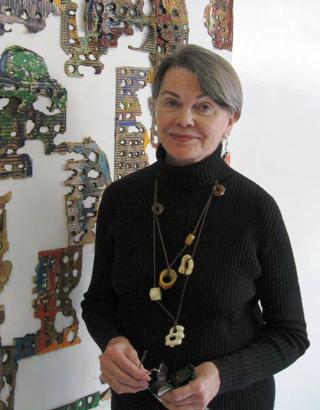
THOMAS G. HALL
Professor Emeritus Thomas G. Hall, Ph.D., passed away March 9, 2023.
Hall taught and was an administrator at Chapman University from 1968 until his retirement in 2001. He also founded the Chapman Chamber Players in the Department of Music, which eventually became the Hall-Musco Conservatory of Music within the College of Performing Arts.
Professor and Department of Music Chair Amy Graziano said Hall was “someone I could turn to for advice no matter the issue.”
CHAPMAN NOW
HILBERT MUSEUM BREAKS GROUND ON EXPANSION
BY STACE DUMOSKI
Chapman University’s HIlbert Museum of California Art celebrated the official groundbreaking of its expansion on Feb. 15. The yearlong construction project will triple the size of the museum, including additional galleries, event spaces, a café and a research library.
Since opening in 2016, the Hilbert Museum has established itself as one of the leading art museums in Southern California, attracting more than 30,000 visitors annually, and has been named as one of the best museums in Orange County by OC Weekly and the Los Angeles Times. The museum’s collection features thousands of California Scene paintings donated by museum founders Mark and Janet Hilbert, and includes collections of animation, movie art and American illustration.
Turner, who praised Owens as “resourceful and energetic.”
Owens’ energy and acumen impressed Orange County entrepreneur and Chapman Trustee Ross Escalette, who, with his wife, Phyllis, established an endowment in 2010 to support the newly minted Escalette Permanent Collection of Art.
Phyllis and Ross Escalette’s daughter, Suzanne Escalette Ellingson, recalls, “The light behind the collection was indeed Maggi Owens. She guided my parents through this project as a mentor and friend. She has left behind an amazing legacy and will be missed.”
Hall, professor of viola performance and music history, chaired the Department of Music twice.

Provost Norma Bouchard noted that a photo of Hall in a bunny suit is displayed in the Henley Reading Room at Leatherby Libraries, “as it was in his tradition to pass out chocolate Easter eggs in costume from about 1973 until his retirement.”
“He loved spreading joy within the Chapman Family,” she said.
Hall is survived by Willy Hall ’64, his wife of more than 50 years.
“The Hilbert Museum serves both Chapman University and our larger Orange community in so many ways,” City of Orange Mayor Dan Slater said at the groundbreaking. “This museum has become not just a showcase for the paintings on its walls, but also a meeting place for all the arts — its rich programming schedule presents talks, films, performances and more. It has become Orange’s de facto cultural living room where local arts lovers gather.”
“[The Hilbert Museum] has become Orange’s de facto CULTURAL LIVING ROOM where local arts lovers gather.”
– Dan Slater
The museum is expected to reopen early in 2024. Until then, visitors can see special exhibitions and highlights from the Hilbert Collection at a temporary location near Orange Plaza. Visit hilbertmuseum.org for more information.
IN MEMORIAM
ONCE A PAN THER, ALWAY S A PAN THER
CONNECT
Keep in touch with your Chapman community, and expand your network. Develop powerful connections that will last a lifetime.
ENGAGE
From mentoring and recruiting future Panthers to attending events, alumni play a vital role both on and off campus.
EXPLORE PERKS
Check out on-campus, online, nearby and Chapman-owned business perks.
INSPIRE
Alumni are the ambassadors of the Chapman Experience, who inspire each other and the next generation of Panthers. Keep us updated on your successes, so we can celebrate you!
GET SOCIAL
Instagram: @chapmanualumni
Facebook: /ChapmanUniversityAlumni
LinkedIn Group: Chapman University Alumni Association (Of ficial)
CARE ER J OURNE Y PARTNERS
1:1 CAREER ADVISING
Job Search Strategy, Resume and Cover Letter Review, Interview Prep and Networking Skills
EMPLOYER CONNECTIONS
Career Fairs, Networking Nights, Job Leads, Information Sessions and Industry Panels
CAREER TOOLS AND TECH
Job Portal, AI Resume Review, Industry Guides, Alumni-Student Engagement, Virtual Mock Interviews, International Resources and Financial Literacy
ON-DEMAND RESOURCES
Industr y Resume Templates, Cover Letter Samples, Guides, Tips, Videos, Diversity Resources and Networking Groups
TALENT PIPELINE SERVICES
Think Chapman First and hire fellow Panthers to join your organization – we'll help you recruit top Chapman talent! ... AND MORE!
Find out more at chapman.edu/career
23983050
Find out more at chapman.edu/alumni
Career and Professional Development
YOUR
PAUL PATON SELECTED TO LEAD FOWLER LAW
BY CERISE VALENZUELA METZGER
“I’m proud to help shape the next chapter of the Fowler School of Law,” says Paul Paton, an internationally recognized expert in legal ethics.
Thomas W. Lawlor Professor of Law and Ethics at the University of Alberta, Canada, where he served as dean of law from 20142019. He previously served as the inaugural vice provost at University of the Pacific and as professor of law at the university’s McGeorge School of Law in Sacramento.

Paton begins at Fowler at a time of growing influence and impact as reflected by the school’s recent rise from No. 118 to No. 109 in the Best Law Schools rankings by U.S. News & World Report.
Paul Paton, an internationally recognized expert in legal ethics, has been named dean of the Fowler School of Law and Donald P. Kennedy Chair in Law. He began his new role at Chapman University on June 30.
Paton is former interim CEO of the Canadian Bar Association and most recently was the
“Paul Paton brings to the Fowler School of Law an unflinching commitment to student success and a passion for learning,” says Chapman Provost Norma Bouchard. “He is a first-generation university student, law student and lawyer. His maternal grandparents were non-English-speaking immigrants to Canada and homesteaders from Ukraine. Paul and his siblings were instilled with the importance of maximizing the benefit of any educational opportunity.”
“I’m honored to have been selected and look forward to serving a community that values bold ambition tempered with humanity,” Paton says. “Events domestic and international — at every level — have challenged lawyers, law students and all of us as citizens in ways that have reinforced as never before the critical importance of what we do as educators, leaders and mentors. The legal profession is changing dramatically, but a commitment to professionalism like Fowler holds is steadfast. The recent U.S. News & World Report rankings confirm that Fowler is on the rise, and I’m proud to help students, staff, faculty, alumni and the community shape its next chapter.”
GRAD PROGRAMS SHINE IN NATIONAL RANKINGS
BY JOY JUEDES
ARGYROS MBA, FOWLER LAW AND PHYSICIAN ASSISTANT PROGRAM MAKE GAINS.
Chapman University’s focus on excellence in its graduate programs has been validated by the most recent rankings from U.S. News & World Report, released in April.
The Argyros School of Business and Economics rose 12 places to No. 60 on the 2023-24 Best Business School list. Fowler School of Law rose from No. 118 to No. 109 among Best Law Schools. The Physician Assistant program at Crean College of Health and Behavioral Sciences broke into the Top 100 in its first-ever ranking.
“I am extremely proud of our depth and growth in these programs, and I’m overjoyed to see our strengths recognized by these national rankings,” said Chapman President Daniele C. Struppa.
For the Argyros School, it’s the highest-ever position in rankings of business schools with full-time MBA programs. The school has ascended 38 places in six years.
“We improved across the board – our program is more selective, has better job outcomes for our students and is better recognized by our peers,” said Argyros Dean Henrik Cronqvist.
The U.S. News ranking of schools with fulltime MBA programs is based on a range of indicators, including career placement success and earnings, student excellence and qualitative assessments by experts.
Law school rankings are based on placement of graduates, faculty resources, achievements of entering students, and
opinions by law schools, lawyers and judges on program quality.
Former Fowler School of Law Interim Dean Marisa Cianciarulo said the ranking jump “speaks not only to several years of tremendous strides in employment outcomes and bar pass, but to the everpresent and passionate commitment to our No. 1 priority: our students’ success.
For the Physician Assistant program, entering the national rankings at No. 96 is just the beginning, Struppa said.
“We anticipate future success in this program as we strive to meet global needs in health care,” he added.
56 | CHAPMAN UNIVERSITY MAGAZINE CHAPMAN NOW
NEGOTIATING TO BRIDGE CULTURAL DIVIDES
BY JOY JUEDES
THREE FOWLER SCHOOL OF LAW STUDENTS TAKE THIRD PLACE IN AN INTERNATIONAL COMPETITION OUTSIDE DUBAI.
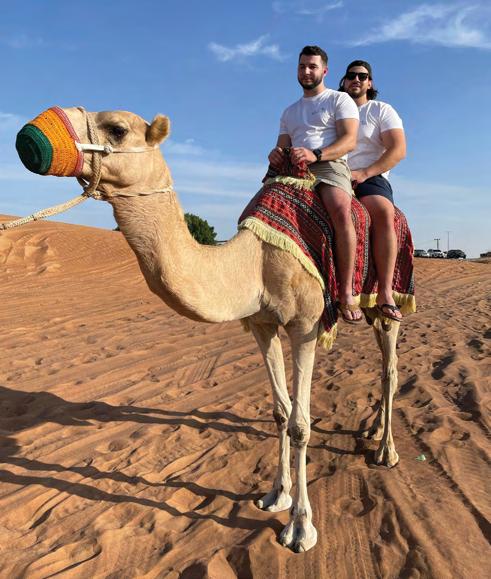
Negotiating legal disputes occurs in many places, but not often in a desert camp outside Dubai.
That’s where three students from Chapman University’s Fowler School of Law placed third among many teams from around the world in a highly competitive negotiation skills competition.
The team – Zakaria Amin (JD ’23), Aram Kazarian (JD ’23) and Tyler Makin (JD ’24) – also went by “The Three Habibis” (“habibi” is an Arabic term of endearment). It was Chapman’s third time at the November competition, which challenges participants to use negotiation skills to resolve a conflict.
“As the world gets smaller … opportunities like this are key,” says Professor Nancy Schultz, who directs Fowler School of Law’s advocacy and dispute resolution certificate and competition programs. “We all need to remember that we are far more similar than different.”
Team members said the competition highlighted both similarities and differences in cultures.
“The opportunity to represent Chapman on the global stage was enticing, but the most appealing aspect was the chance to explore a completely foreign part of the world and meet people from countries and cultures that I’ve only read about,” Makin says.
Amin, who competed for the second year in a row, says the practice of alternative dispute resolution “seems to unify advocates from across the world because the goal is to find creative solutions to problems.”
“It was beautiful to see all of us bring our own unique approach to resolving disputes and learn and grow from one another,” he adds.
Competing against teams from around the world forced the team to “rethink how we communicate and what assumptions we are making,” Makin says.
Kazarian says he got to “experience styles of negotiation I might otherwise not encounter.”
The competition’s final round was held at a tent camp in the desert and included traditional food and entertainment of the region. Amin, an Arabic speaker whose parents emigrated to the United States from Syria, enjoyed sharing what he understood of the local culture.

Schultz says she is always excited to give students opportunities to travel abroad.
“We all need to get out of our comfort zones now and then,” she says. “And Chapman aims to shape global citizens — this is the perfect way to do that.”
Makin says the competition “opened my eyes to the breadth of opportunities that a law degree can create.”
The chance to compete in Dubai differentiates Chapman, he says.
“Whether a student is interested in foreign diplomacy, professional sports or something completely different, Chapman has an opportunity for anyone willing to put in the work to succeed,” he says.
Fowler School of Law’s negotiation team with their award, top. Bottom, Kazarian and Amin on a camel.
SUMMER 2023 | 57 CHAPMAN NOW
STRENGTHENING CHAPMAN’S FINANCIAL FUTURE
 BY JOY JUEDES
BY JOY JUEDES
JANNA BERSI PROVIDES LEADERSHIP AS THE UNIVERSITY’S FIRST VICE PRESIDENT OF INVESTMENTS, WHILE ALSO SERVING THE WIDER HIGHER EDUCATION COMMUNITY.
CHAPMAN NOW
58 | CHAPMAN UNIVERSITY MAGAZINE
As Chapman University’s first vice president of investments and administration, Janna Bersi has already applied her expertise on campus and beyond – even across the globe.
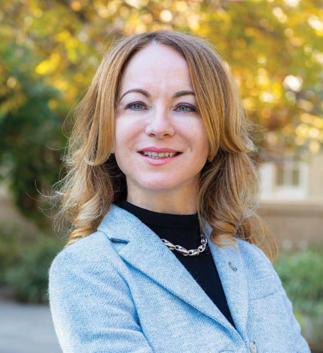
Bersi, who was appointed to her post in July 2019, led a Western Association of Schools and Colleges Senior College and University Commission (WSCUC – pronounced WASC) five-member team to India in late September to evaluate Amity University. WSCUC accredits higher education institutions in California, Hawaii and around the world.
“It’s a lot of work and it’s grueling, but it’s also very prestigious … it’s a very high level of responsibility to serve on a WSCUC accreditation team,” Bersi says.
Bersi, who earned her doctorate in organizational leadership from Pepperdine University, got involved with WSCUC 13 years ago. She was a commissioner, chaired different committees, and has served on several accreditation visit teams. She also served on the board of Western Association of College and University Business Officers and chaired two of its committees.
That’s all in addition to her role at Chapman, in which she manages the university’s endowment and investments. Although she has been in her current position for a few years, she first came to Chapman in 2006 to serve as vice president of finance and CFO.
She brought with her a broad range of financial and management experience from working at the foundation of her alma mater, California State University, Long Beach. She was at Chapman for three years, then went to California State University, Dominguez Hills, where she was responsible for a $90 million academic affairs budget.
When the Great Recession hit, she and her colleagues had to figure out how to manage a university significantly reduced by the state in 2009.
“You really have to understand all of the intricacies of the academy and its operations and work with a lot of different people to negotiate and get things accomplished,” says Bersi, who also taught as a tenured professor at the graduate level at Dominguez Hills.
Chapman recruited her to return and start the investment office after the Board of Trustees voted in December 2018 to make the growth of Chapman’s endowment a major strategic priority. The endowment’s market value at the time was just below $400 million. The endowment initiative was undertaken because a study of peer institutions showed that it is prudent to have internal management of endowment operations once the endowment reaches $500 million, Bersi says.
That goal was surpassed in 2020-21, and today the endowment stands at more than $600 million.
Janna Bersi brings a broad range of financial and management experience to her role as Chapman’s vice president of investments and administration.
“As the Chapman endowment grew, it was necessary to establish our investment office and to form a team exclusively devoted to managing our endowment,” says Trustee Jim Burra, who chairs the Board Investment Committee. “We were fortunate to recruit Janna Bersi. She established the office, built the management systems and hired an outstanding staff.
“Janna’s foresight allows Chapman to handle significant growth in the endowment. As a trustee and chairman of the Investment Committee, I am confident that Janna will continue her outstanding efforts in the pursuit of our ambitious goals,” he says.
In February 2019, the National Association of College and University Business Officers reported that Chapman’s endowment was the third-fastest-growing private university endowment in the nation. Bersi is quick to share credit for the accomplishment.
“It will take and does take a village,” she says. “It’s an extraordinary effort on behalf of the university and in particular its Board of Trustees and leadership.”
Another “village” effort Bersi is part of is Chapman’s new strategic plan, which sets an ambitious $2 billion endowment goal for 2037.
“Why would we strive for such an audacious target? Because Chapman, in rising to national prominence,, is competing with a new pool of peer institutions – most of which are heavily endowed,” she says.
Not only will Chapman be better positioned to compete, Bersi says, but a significantly larger endowment will provide for the very longterm support of academic programs and research that the university doesn’t currently have.
“Generations of students will benefit from the support that our efforts today will establish,” she says.
SUMMER 2023 | 59 CHAPMAN NOW
GENERATIONS OF STUDENTS
WILL BENEFIT FROM THE SUPPORT THAT OUR EFFORTS TODAY WILL ESTABLISH.
“ “
– JANNA BERSI
“We care about sustainability and we want to reduce waste, but at the same time, how







Once Disney reaches its 2030 sustainability goals – net-zero greenhouse gas emissions, zero waste to landfills, and other steps –“I don’t think there’s anyone out there who
Thai’s work toward zero waste at the Disneyland Resort involves both
“I can put the right kind of landfill can, mixed recycling can and food can out there, but how do I get guests and cast members to actually use it correctly?” she says.
ALUMNI NEWS




1960s
Reggie Van Driest II ’69 retired after more than 40 years as a psychoanalyst with the U.S. Defense Intelligence Agency.
1980s
Tina Noe ’80 published a collection of true crime articles, “I Spy, You Spy, They Spy.” It is the third in a series of four works in the collection. 1
Mitchell Grobeson ’81 wrote a biography of Bong Soo Han, a master of the Korean martial art hapkido. Han worked with Bruce Lee and helped the CIA create their Phoenix Program, designed to undermine the Viet Cong during the Vietnam War. Grobeson did 15 years of research for the book. 2
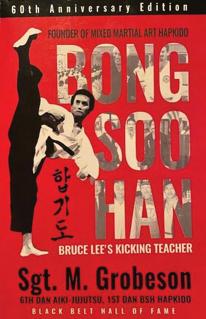
Jeffrey Cousins ’85 wrote a book, “The Right Thing to Do.” The sci-fi novel tells the story of a captured alien’s revelations to humanity and people’s reactions to what is revealed. 3
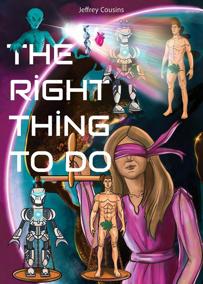
Scott Marshutz ’87 produced “Wounded Land,” a documentary about how Ukrainian vintners are continuing to produce during wartime conditions. The film was released worldwide earlier this year and chosen for screening at the Docs Without Borders International Film Festival. Photo by Kimble Photography. 4
Lynn Griesemer (MS ’88) wrote a book, “Porn Free: How to Decrease the Demand for Pornography.” The work examines the consequences of pornography and gives preventive steps to curb demand. 5
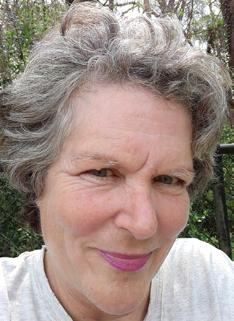

1990s
Heather Backstrom (MS ’92) wrote a women’s leadership book, “Collaborative Confidence: How Women Leaders Can Activate Self-Awareness, Amplify Their Authentic Talents and Accelerate Workplace Change.” Backstrom used stories, research and her coaching experience to encourage women to use their core values and strengths in how they lead. 6
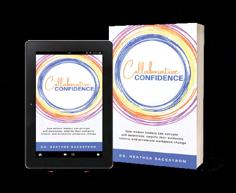
Echo Baker ’93 was given the Award of Excellence at the Oil Painters of America Western Regional Exhibit in Dallas.
Jolene Zigarovich (MA ’95) wrote a book, “Death and the Body in the Eighteenth-Century Novel.” The book explores the history of death in the Enlightenment and how it was transformed in narratives. The book was released in January. 7

Beverly Watley (MA ’98) has branched out from education to freelance journalism. She has published pieces in print and online, including in BLAC Detroit magazine. Her goal is covering “newsworthy and challenging topics with the hope of inspiring courageous conversation.”
Mike Rucker (MFA ’99) wrote a book, “The Fun Habit.” The work explains how people can make having fun a habit and why it will “help you become a healthier, more joyful, more productive person.” 8
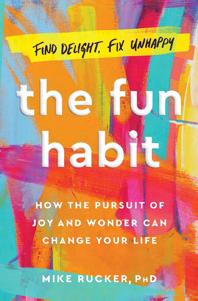

2000s
Jude Atwood (MFA ’00) wrote a book, “Maybe There Are Witches.” The novel, about a 13-year-old girl who discovers messages from an ancestor who was executed as a witch, won the Kraken Book Prize for Middle Grade Fiction from Fitzroy Books.
CLASS NOTES 62 | CHAPMAN UNIVERSITY MAGAZINE
1 2 3 4 5 6 7 8
Tim Lightell (MFA ’03) directed and produced his first commercially distributed feature, the comedy “Manbaby.” The film was coproduced by Joseph Campanale (MFA ’04) and released on the West Coast in August 2022. It is streaming on Amazon Prime and Tubi. 9

Patrick Hardy ’04 wrote a book, “Design Any Disaster: The Revolutionary Blueprint to Master Your Next Crisis or Emergency.” The book explains how people can turn disasters into opportunities to make their life more resilient. During the California ShakeOut in October, he will run the world’s first live-streamed disaster drill from a school in the Bay Area. 10

Cat Kozlowski ’04 (JD ’07) was honored as one of the “40 Best LGBTQ+ Lawyers Under 40” by the National LGBTQ+ Bar Association at the Lavender Law Conference in Los Angeles. Kozlowski also moderated a panel at the conference, “Leveraging Legal Skills, Limited Time, and Bar Associations to Help LGBTQ+ Youth at the Local Level.” 11
Mike Brown ’06 started his own business consulting company, Impact Grove in Irvine. Impact Grove helps businesses with ESG impact assessments, B corporation certification and strategic planning. 12

Theresa Bimbela (MA ’07) received a Women of Distinction Accelerate grant from the National Association of Women Business Owners of Southern Nevada. She owns TAB Professional Services, which provides grant, project and event management and other administrative services. 13

Krystal Weaver (M.Ed. ’08), an attorney in the San Diego office of Littler Mendelson P.C., was elevated to shareholder status at the firm. The employment and labor law firm named 28 attorneys shareholders throughout its U.S. and Mexico offices. 14

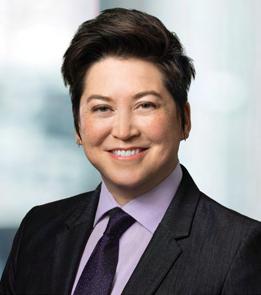
2010s
Lorenzo Gonzalez ’11 became president of the Southern California chapter of the Committee of Interns and Residents, the country’s largest union of physicians. Gonzalez is the chief resident for HarborUCLA Medical Center’s family medicine residency. 15

Megan Demshki ’12 (JD ’15) was promoted to partner at Aitken Aitken Cohn in Riverside. Demshki was Student Government Association president at Chapman and met the firm’s founding partner and longtime Chapman trustee Wylie Aitken through the university. Aitken encouraged Demshki to attend the Fowler School of Law at Chapman and later hired her at the firm. 16
Meera Kharbanda ’13, Marissa Goldenstein ’13 and Kendra Azure ’13 opened a private elementary school in San Clemente called InWonder Academy. The school enrolls students in transitional kindergarten through first grade, with plans to expand through grade six by 2028. 17
Maia Cooper ’14 wrote a children’s book, “Everybody Deserves a Home,” about affordable housing. It was featured in the trade publication Affordable Housing Finance. Cooper’s first-year Henley Hall roommate, Valerie Valdivia ’14, illustrated it. 18
Daniel Fister ’14 received a Ph.D. in musicology from Washington University in St. Louis. His dissertation topic was “Scholastic A Cappella and the Construction of Whiteness, Community, and Power.” He will be teaching courses on music and race at the collegiate level in San Jose. 19
CLASS NOTES
9 10 11 12 13 14 15 SUMMER 2023 | 63
Steven Babiak ’15 was recognized in Phi Delta Theta fraternity’s first “30 Under 30” class, alongside fellow alumni Jim Byron ’15 and Josh Nudelman ’16. Babiak, a vice president in investment banking at MUFG Bank, was chosen to work on renewable power and infrastructure asset transactions at MUFG’s global headquarters in Tokyo for three months. 20
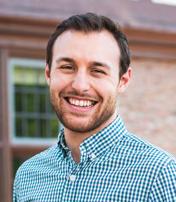

Wes Rapaport ’15 was awarded an Emmy from the National Academy of Television Arts & Sciences’ Lone Star Chapter for his role in KXAN-TV’s weekly program “State of Texas.” He was honored for an episode addressing protests against police brutality. 21
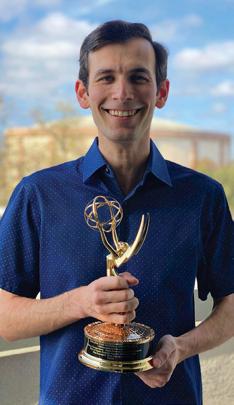
Emily Risbrough ’15 and Tim Seavey ’15 celebrated their wedding July 11, 2022, in Lake Tahoe. Chapman alumnus David Taylor ’16 was in the wedding party. The couple “had too many other Chapman Family members in attendance to name them all, but we loved sharing the experience with all of them,” they say. 22
Nieman Gatus ’17 released a new pop/R&B single, “Fashionably Late,” in February leading up to the launch of a new EP. He has toured in and been honored as a musician in the Philippines, and has more than 50 million streams on Spotify. Last January, Gatus headlined a show at the Observatory venue in Santa Ana, “where I produced my thesis film when I was still a student,” he says. 23
Sydney Jacobs ’17 and Ryan Westra ’14 celebrated their wedding on Oct. 15, 2022, at Valentine in Los Angeles. Although they both graduated from Chapman, they didn’t meet until 2018. Other Chapman alumni in the wedding party were Ben Fischinger ’14, Drew Heskett ’14 and Nathan Mulroy ’17. Gabe Linkiewicz ’14 officiated. Jacobs and Westra honeymooned in Italy. 24

Sofia Seikaly ’17 was awarded an Emmy from the National Academy of Television Arts &

Sciences’ Pacific Southwest Chapter in the “Breaking News – Multiple Reports” category.
Elijah Richardson ’18 was named one of Dance Magazine’s “25 to Watch.” His recent performances include guest appearances with South Chicago Dance Theatre at the Harris Theater.
Aubrey Van Dyke ’18 and Adam Ginell ’17 celebrated their wedding on Aug. 26. 2022, in West Linn, Ore. They met at Chapman. Other Chapman alumni in the wedding party were Sarah Tabsh ’18, Makenna Sewell ’18, Lauren Friend ’19 and Daryn Link ’19. Van Dyke and Ginell honeymooned in Maui. 25
Jordyn Romero ’19 and Leah de Leon ’19 released their first film, “We Are Like Waves,” a documentary about a woman who becomes one of Sri Lanka’s first female surfers. Romero and de Leon started the film a few months after graduation. 26
2020s
Melissa Borgmeyer ’20 was promoted to Nashville Fair event coordinator for The Fairgrounds Nashville. In addition to putting on the fair, she works with media, the agriculture industry, educators and nonprofits. 27
Ariana Diaz ’21 joined O’Donnell Real Estate in Laguna Hills as a Realtor. She says her communications degree with a leadership emphasis allows her to give clients “the highest level of communication and service.”
Erin Craw (Ph.D. ’22) was named director of research at Lighthouse Health & Wellness, a public benefit corporation that supports the health of first responders. The Foothill Ranchbased corporation was founded by Joe Ramirez ’99.
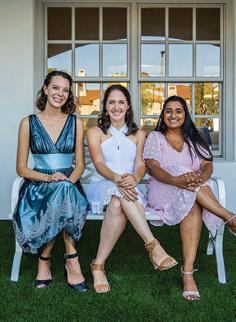
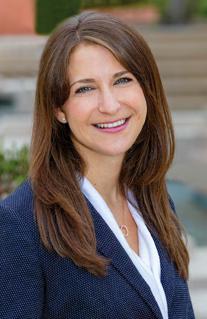
CLASS NOTES 64 | CHAPMAN UNIVERSITY MAGAZINE
16 17 19 20 21 22 18
FRIENDS WE WILL MISS


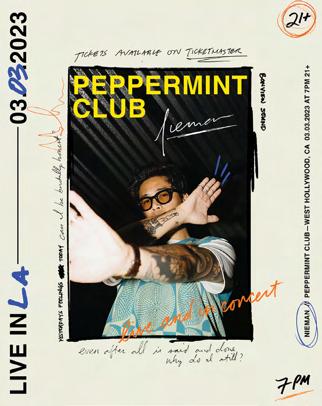
BOB HAMBLIN ’59 passed away Dec. 26, 2022. A U.S. Air Force veteran and longtime high school teacher and basketball coach, Hamblin was Chapman’s first All-American and was honored in the first class of Chapman Athletics Hall of Fame inductees. He led the Panthers to the NCAA men’s basketball tournament in 1958 and still holds the school record for career rebounds with 1,326. Chapman retired his number, 54.

ELLA ST. ANDRE (MA ’99) passed away Oct. 26, 2022. She started a successful packaging company in 1980 and later became a marriage and family therapist. She is survived by her two daughters, two sisters and a brother as well as grandchildren, nieces and nephews.

VANESSA MARTIN BOURQUE ’08 passed away Oct. 8, 2022. She will be missed by the many people whose lives she touched. She is survived by her two sons, ages 10 and 6.



CLASS NOTES
23 24 25 26 27 SUMMER 2023 | 65
CHAPMAN IN HOLLYWOOD
A SUPERSIZED ‘SMILE’
BY DENNIS ARP
PARKER FINN (MFA ’11) IS READY TO BUILD ON HIS HORROR FILM’S HUGE SUCCESS AND THE “GREAT FOUNDATION” HIS CHAPMAN EXPERIENCE PROVIDED.
WRITER-DIRECTOR
Even though he has enjoyed critical success, filmmaker Parker Finn (MFA ‘11) does his best to avoid the thrall of reviews. “It’s like wading into quicksand,” he says.
But in the months after his debut feature was released, there was a vortex into which he plunged with delight: tracking the box office returns. There was no wiping the grin off his face as “Smile” blew past $200 million in gross receipts worldwide. Not bad for a movie with a $17 million budget.
“It’s been surreal information to engage with,” he admitted.
Never would he have allowed himself to conjure such blockbuster thoughts when he first fell in love with horror movies as a youngster growing up in Akron, Ohio. Nor when a filmmaking career began to blossom as he pursued his MFA in screenwriting at Chapman University.
“My interior cynicism and neuroses would never let me anticipate this,” says a smiling Finn, who honed his craft in Chapman’s Dodge College of Film and Media Arts. “Everybody who wants to make movies
dreams of making something that’s seen widely and embraced, but I wasn’t scheming toward this by any means.”
FROM STREAMING TO THEATRES
Finn’s success turning his 2020 short film “Laura Hasn’t Slept” into the feature-length “Smile” really took off after Paramount flipped the film from straight-to-streaming to a theatrical release. It was a moment to celebrate – and to take a deep breath.
“I was very excited for everyone to see the film, but when you make a film for streaming, you’re kind of off the hook for its performance,” Finn says. “With the switch to theatrical, now if it doesn’t connect with audiences, it could be a bit of an albatross around my neck.
What’s the opposite of an albatross? Because Finn’s neck is just fine. The reviews were positive – the New York Times called “Smile” “precision-tooled” and “intensely creepy” – and the film opened at No. 1 in the U.S., then thrived in 62 overseas markets as well as on Paramount+.
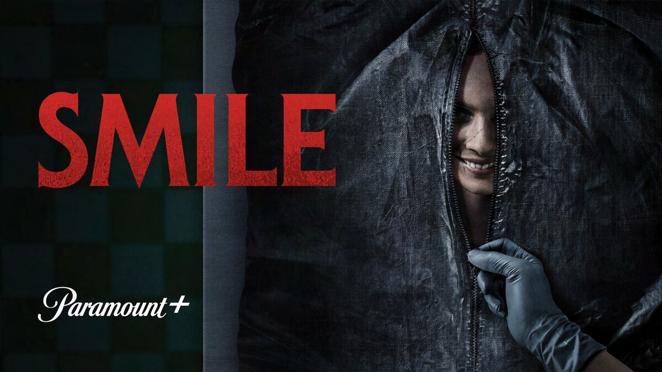
A ‘MASTERFULLY MADE HIGH-CONCEPT HORROR FILM’
Finn is reluctant to dive too deeply into why “Smile” grabbed and held audiences.
“I was making a love letter to the cursed-chain stories and films I’ve been enamored with, but I wanted to drop this different kind of character into one of those films – someone who has a lot of personal baggage and melodrama in her life,” he says. “So I hesitate to try to game theory why that worked or didn’t work for people, because it was just me following my instincts and interests.”
During his MFA studies, Chapman helped shape Finn’s artistic sensibilities as the Dodge College filmmaking community also bolstered his confidence and skills, he says.

“It definitely created a foundation for me,” he adds. “What I really liked was being surrounded by people who want to talk about movies all the time and who have really engaging and thoughtful opinions on things. That was amazing and so inspiring. I was inspired by everyone around me –students and professors. I loved eating, breathing and sleeping film for my two years in the master’s program.”
These days, Finn is surrounded by opportunities, including consideration of a sequel.
“There are definitely certain corners of the world of ‘Smile’ that I purposely left unexplored and I think could be really exciting to continue forward with,” Finn says. “But I also want to make sure that if there were to be more ‘Smile,’ that it felt very unexpected and exciting and had all kinds of new tricks up its sleeves.”
For his next trick, Finn will try to build on his debut success even as he also enjoys the balmy glow of many happy returns.
Just try to keep him from smiling.
66 | CHAPMAN UNIVERSITY MAGAZINE ALUMNI NEWS
JUSTIN SIMIEN ’05 ENJOYS THE RIDE

TV CAREERS ON COURSE
When many of the best golfers in the world teed it up in February at the Genesis Invitational in Los Angeles, five Chapman University students worked alongside them, helping to capture the PGA tournament action for a global viewing audience.

The five are all first- or second-year students in the Broadcast Journalism and Documentary program at Chapman. The students assisted camera operators and captured audio for PGA Tour Live on the ESPN+ streaming service.
“Working with this level of equipment and getting this kind of experience when you’re 18 or 19 is something you’re really not going to get anywhere else.”
“This mansion is unhinged.”
That declaration, intoned by Owen Wilson in a trailer for “Haunted Mansion,” might also describe the otherworldly buzz for the Disney feature, due in theatres July 28.
Director Justin Simien ’05 (“Dear White People,” “Bad Hair”) seems totally at home bringing this “Mansion” to the masses.
“For me, there was something about that ride I felt was there in the script,” the Chapman grad said during last year’s D23 Expo in Anaheim. “It was funny and full of interesting characters, but it had a little bit of a dark edge to it. I just really related to it. It felt I knew how to make it. I felt like I understood New Orleans. And I’m a fanboy.”
Like many Chapman students and alumni, Simien’s connection to Disney includes a summer gig at Disneyland during his formative years.

“Anytime I wasn’t working on the ride I was supposed to, I’d ride Pirates and my favorite ride, Haunted Mansion,” he said.
Now Simien gets to guide his favorite ride to the screen as he also coaxes out the best in a dream cast, which includes Rosario Dawson, Danny DeVito, Jamie Lee Curtis, Jared Leto, Tiffany Haddish and LaKeith Stanfield.
“I felt I understood the ride, and I had a responsibility to make sure all the details – all the little easter eggs – are there because I’m a nerd for real,” he said.
Their ongoing experience covering Panther football, basketball and other athletic events for the Chapman Sports Broadcast Network (CSBN) prepared them to thrive in the professional setting, they say.
“We’re used to working with industry-level equipment and learning about every technical aspect of a broadcast,” said Ben Sherman ’25.
NEW VOICE FOR DODGERS AND MLB
Like Sherman and the other Dodge students (Kaylee Smith ‘25, Zack Richter ‘26 and Zach Lipfield ’26) working the PGA events, Emily Cho ’25 is preparing for a career in professional sports at the highest levels of broadcasting.
“I want to work for the Golf Channel, but I definitely didn’t expect to get into the industry so soon,” says Cho, who also competes on the golf team at Chapman. “I’ve made a ton of contacts and learned a lot about the technical aspects of the industry. It’s a great gateway to a professional career.”
In addition to his experience as an MLB Network host and broadcaster, Nelson counts among his credits roles as sports director, producer and host on Chapman Radio as well as a public address announcer for Chapman Athletics.
Now as a Major League Baseball play-byplay broadcaster, Nelson joins Dodge and Chapman Radio alumnus Jeff Levering ‘05, who is in his eighth season announcing Milwaukee Brewers games.
Working on the SportsNet LA team, Nelson understands the history that surrounds him in a booth that previously was home to legendary announcer Vin Scully.
As students working for the Chapman Sports Broadcast Network find their way to professional success, they can also find inspiration in the journey of Dodge alumnus Stephen Nelson ‘10, who this season stepped into the role of play-by-play announcer for the Los Angeles Dodgers.
“It’s impossible to convey the emotions that come with this opportunity,” Nelson said in a news release announcing his new role. “This isn’t simply coming home. …This is the Los Angeles Dodgers. It’s the best organization in baseball for so many reasons.”
Nelson is also making history as the only Asian American play-by-play announcer in MLB.
SUMMER 2023 | 67 ALUMNI NEWS
One University Drive
Orange, California 92866







Chapman.edu




SEPTEMBER 22 & 23, 2023


Come for the football, stay for the fun, food and family!
Join us on Homecoming weekend to reconnect with your fellow Panthers, cheer for our students and celebrate everything that makes Chapman feel like home.
Chapman.edu/ homecoming
Chapman on the Road
When you can’t make it home to Chapman, we’ll bring Chapman to you! Watch your email for details about our new series of regional events where you can connect with Chapman wherever you are.

























 Above: Austin Butler spends a moment with students; Brendan Fraser joins in a Q&A moderated by Scott Feinberg, Chapman trustee professor and executive editor of awards at The Hollywood Reporter.
Left: Ke Huy Quan, Todd Field, Joel Cohen and Deborah L. Scott share insights and smiles during a standout season of master classes at Dodge College.
Above: Austin Butler spends a moment with students; Brendan Fraser joins in a Q&A moderated by Scott Feinberg, Chapman trustee professor and executive editor of awards at The Hollywood Reporter.
Left: Ke Huy Quan, Todd Field, Joel Cohen and Deborah L. Scott share insights and smiles during a standout season of master classes at Dodge College.





 - KE HUY QUAN
- KE HUY QUAN










 BY STACE DUMOSKI
BY STACE DUMOSKI



 Choreographer Dwight Rhoden observes as dancers from Complexions Contemporary Ballet practice a dance that will be performed to the music of rocker Lenny Kravitz.
Choreographer Dwight Rhoden observes as dancers from Complexions Contemporary Ballet practice a dance that will be performed to the music of rocker Lenny Kravitz.










































 School of Communication graduate Carmen Chavez ‘22 shows off her first-generation Trailblazer stole.
School of Communication graduate Carmen Chavez ‘22 shows off her first-generation Trailblazer stole.































 BY JOY JUEDES
BY JOY JUEDES












 BY JOY JUEDES
BY JOY JUEDES





















































